Category: Transfer Pricing News
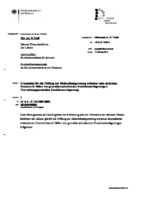
German Guidance on Business Restructuring and Valuation issued in October 2010
In 2008 German legislation on business restructurings was updated to align with the new chapter XI in the OECD Transfer Pricing Guidelines. § 1 para. 3 AStG and the “Regulation on the application of the arm’s length principle according to §1 para. 1 AStG in cases of cross-border relocation of functions” of 12.8.2008 (Function Relocation Regulation, in short: FVerlV). Guidance was subsequently issued by the tax authorities in BMF letter of 13 October 2010, IV B 5 – S 1341/08/10003, BStBl 2010 I p. 774; in short: VWGFVerl. Click here for unofficial English translation Click here for other translation
WCO Guide to Customs Valuation and Transfer Pricing
In June 2015 the World Customs Organization (WCO) published a guide to Customs Valuation and the relationship to Transfer Pricing. This relationship between Customs valuation and transfer pricing has been discussed in various national and international fora over the past few years. The business community has raised the issue as a matter of concern, in particular advocating that Customs take into account available transfer pricing information prepared for direct tax purposes when examining related party transactions and also give consideration to the impact of transfer pricing adjustments on the Customs value. It has been recognised that at this stage any alignment or merger of tax and Customs methodologies is not a realistic proposition given the particulars of the existing legal frameworks upon which they are based. The essence of the issue therefore is contained in the following question: to what extent can information contained in transfer pricing documentation, primarily developed for taxation purposes, provide useful information for Customs to determine whether or not the price declared for imported goods has been influenced by the parties’ relationship, in order to make a final determination of the Customs value? The Technical Committee on Customs Valuation has confirmed the basic principle that transfer pricing documentation may provide useful information for Customs in respect of related party transactions, on a case by case basis (see Chapter 4). The focus is now on providing further guidance to Customs on how to examine and interpret transfer pricing documentation which may be helpful in this regard. The other key question is the impact of adjustments made (after importation) for transfer pricing purposes; in which cases, if any, should such adjustments be taken into account by Customs in determining the Customs value of the imported goods? Additionally, the WCO is working with the OECD and World Bank Group to encourage Customs and tax administrations to establish bilateral lines of communication in order to exchange knowledge, skills and data, where possible, which will help ensure that each authority has the broadest picture of a MNE’s business, its compliance record and can make informed decisions on the correct revenue liability.
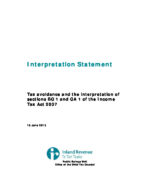
Statement released by New Zealand’s Inland Revenue on determining whether an Arrangement is Tax Avoidance
On 13 June 2013, a Statement was released by New Zealand’s Inland Revenue Service on the interpretation of Tax Avoidance provisions. This statement outlines the Commissioner’s view of the law on tax avoidance in New Zealand and sets out the approach the Commissioner will take to application of the general anti-avoidance provision, based on the three-stage test for assessing whether an arrangement is tax avoidance as provided by the Supreme Court Judgment in the Ben Nevis case. In Ben Nevis case the Supreme Court indicated it intended to settle the approach regarding the relationship between s BG 1 and the rest of the Income Tax Act. This has been acknowledged in all relevant judicial decisions released since Ben Nevis. Accordingly, the Commissioner considers that the statement is based upon and reflects the view of the court in Ben Nevis.
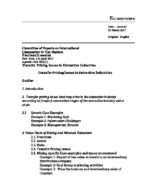
UN Guidance Note on Extractives (Oil, Gas, Minerals)
The UN Transfer Pricing Manual does not address industry-specific issues, but, in 2017 a guidance note was developed by a subcommittee looking into transfer pricing issues in extractive industries, both relating to the production of oil and natural gas and relating to mining and minerals extraction. The note draws on materials that have been published in other fora, including the Platform for Cooperation on Tax (hereafter: “the Platform”), reflecting enhanced collaboration between the IMF, OECD, UN and WBG for the benefit of developing countries. Reference can be made to the Discussion Draft published by the Platform on Addressing the Information Gaps on Prices of Minerals Sold in an Intermediate Form and the Discussion Draft presenting A Toolkit for addressing Difficulties in Accessing Comparable data for Transfer Pricing Analyses. Reference can also be made to the WBG’s Extractive Industries Transparency Initiative and materials3 and the publication Transfer Pricing in Mining with a Focus on Africa. Table 1 in the first part of the note identifies some of the transfer pricing issues that often arise in the extractive industries. The table is organized by reference to the various major stages in the extractive industry value chain. The table makes some general suggestions on methods and approaches that might be used in addressing the identified issues. Thereafter, the guidance note provides several case examples, some of which result from discussions with tax inspectors working in developing countries. Taken together, the table and the examples provide useful background information for developing countries to utilize in addressing transfer pricing issues in extractive industries. The note does not aspire to provide comprehensive transfer pricing guidance for the extraction industries, but should provide a useful summary and checklist of some of the issues that commonly arise. It is recommended that this extractive industry guidance note and the Manual be consulted together.
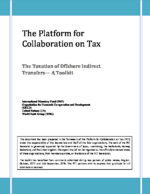
A Toolkit on the Taxation of Offshore Indirect Transfers
The Platform for Collaboration on Tax (IMF, OECD, UN and the WBG) has published a toolkit on the taxation of Offshore Indirect Transfers. The tax treatment of ‘offshore indirect transfers’ (OITs) – in essence, the sale of an entity owning an asset located in one country by a resident of another – has emerged as a significant issue in many developing countries. It has been identified in IMF technical assistance work and scoping by the OECD, but was not covered by the G20-OECD project on Base Erosion and Profit Shifting (BEPS). In relation to the extractive industries, OITs are also the subject of work at the UN. The country in which the underlying asset is located may wish to tax gains realized on such transfers – as is currently the case for direct transfers of immovable assets. Such treatment might reasonably be applied to a wider class of assets, to include more those generating location specific rents—returns that exceed the minimum required by investors and which are not available in other jurisdictions. This might include, for instance, telecom licenses and other rights issued by government. The report also recognizes, however, that gains on OITs may be attributable in part to value added by the owners and managers of such assets, and that some countries may choose not to tax gains on OITs. The provisions of both the OECD and the UN Model treaties suggest wide acceptance that capital gains taxation of OITs of “immovable” assets can be imposed by the location country. It remains the case, however, that the relevant model Article 13(4) is found only in around 35 percent of all Double Tax Treaties (DTTs), and is less likely to be found when one party is a low income resource rich country. To date, the Multilateral Convention has increased the number of tax treaties that effectively include Article 13(4) of the OECD MTC. This impact is expected to increase as new parties sign the MC and amend their covered tax treaties to include the new language of Article 13(4). Whatever treaties may or may not come into play, however, such a taxing right cannot be supported without appropriate definition in domestic law of the assets intended to be taxed and without a domestic law basis to assert that taxing right. There is a need for a more uniform approach to the taxation of OITs by those countries that choose to tax them. Countries’ unilateral responses have differed widely, in terms of both which assets are covered and the legal approach taken. Greater coherence could enhance tax certainty. The report outlines two main approaches to the taxation of OITs by the country in which the underlying asset is located – provisions for which require careful drafting. It identifies the two main approaches for so doing and provides, for both, sample simplified legislative language for domestic law in the location country. One of these methods (‘Model 1’) treats an OIT as a deemed disposal of the underlying asset. The other (‘Model 2’) treats the transfer as being made by the actual seller, offshore, but sources the gain on that transfer within the location country and so enables that country to tax it. The report expresses no general preference between these: the appropriate choice will depend on countries’ circumstances and preferences. In the toolkit reference is made to the following caselaws India—The Vodafone Case Peru—The Acquisition of Petrotech Uganda—The Zain Case
Disneyland Paris under tax investigation
French Tax Officials raided Disney’s Paris Office. The tax investigation focuses on a fee that Disneyland Paris paid for use of Disney’s intellectual property. The same payment appeared to be associated with services provided by a U.K. unit tasked with managing “Disney activities in Europe, the Middle East and Africa since 2011,”. The problem, in this case, is that the company’s decision to combine the two costs made it impossible for tax officials to confirm whether the pricing had been at arm’s length. Disney lost four lawsuits it filed to challenge the order authorizing French tax officials to raid the Paris offices. The rulings noted tax authorities’ concerns spring from an audit of the Paris-based subsidiary’s tax filings from 2012 to 2015. More than 90% of the French Disney unit’s profit was sent to the U.K. during the first half of the decade. Four years ago, The Walt Disney Co. was under fire after investigative reporters with the International Consortium of Investigative Journalists revealed the company sought to benefit from secret tax-saving deals in Luxembourg. This arrangement may have helped Disney reduce its tax payments in the U.S. and Europe, according to the report.
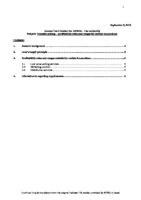
Israel – Guidance on Limited Risk Distribution – Circular 11/2018
Circular on transfer pricing – profitability rates and ranges for certain transactions – Limited Risk Distributors (LRDs)

German royalty barrier to counter IP box-regimes
Some countries in Europe offer so-called IP or Patent boxes. To counter such tax practices, effective from 31 December 2017, Germany has introduced a new royalty barrier in ‘Law against Harmful Tax Practices in Connection with the Assignment of Rights. The law limits tax deductibility of expenses for the assignment of rights in order to prevent royalty income from not being taxed or taxed at a low rate and taxes income in the country where value is/was created. Deduction of expenses for the assignment of rights is restricted, where the following two cumulative requirements are met: 1) Royalty income for the assignment of rights is subject to low taxation which differs from standard taxation in the recipient’s country (preferential regime) 2) The licensor is a related party to the licensee within the meaning of Section 1 Paragraph 2 German Foreign Tax Act. Under these circumstances, expenses are not (or only partially) tax deductible. The non-deductible part of these expenses is calculated as: (25% – income tax burden in %) / 25%. The royalty barrier does not apply if low taxation is the result of a preferential regime of the licensor’s income that follows the Nexus Approach according to Chapter 4 of the OECD’s Action 5 final report.

Israel – Guidance on Limited Risk Distribution – Circular 12/2018
Circular on transfer pricing – profitability rates and ranges for certain transactions – Limited Risk Distributors (LRDs)

UK – Profit Diversion Compliance Facility (PDCF) Published by HMRC January 2019
HMRC Profit Diversion Compliance Facility Chapter 1 – introduction 1.1 Background Companies should recognise and pay tax on profits where the economic activities to generate those profits are carried out. HMRC has found that some Multinational Enterprises (MNEs) have adopted cross border pricing arrangements which are based on an incorrect fact pattern and/or are not consistent with the Organisation for Economic Co-operation and Development (OECD) Transfer Pricing Guidelines (TPG), as clarified through Actions Points 8-10 of the OECD Base Erosion and Profit Shifting Project. This is for 2 main reasons: Firstly, some have made incorrect assumptions, or not implemented arrangements as originally intended or declared to HMRC, so that there is a divergence between the fact pattern on which the Transfer Pricing (TP) analysis is based, and what is actually happening on the ground. This could be for a variety of reasons, including: insufficient understanding or incorrect/misleading statements on the nature or relative value of functions, assets and risks at the outset businesses change over time so that the functional profile may become different from that originally assumed or intended some businesses undervalue the contributions made by staff in the UK and overvalue the contributions of staff in other tax jurisdictions Secondly, the TP policies are not in accordance with the OECD TPG, for example because of: over reliance on TP policies predicated on contractual assumption of risk and legal ownership of assets, giving insufficient weight to the location of the control functions and/or the contributions to those control functions in relation to the risk and/or the important functions in relation to the assets too heavy a reliance on inappropriate comparables These arrangements often result in a reduction of UK profits, and may involve the diversion of UK profits to an overseas entity where the profits are taxed at lower rates or not at all. In a high proportion of investigations into such arrangements HMRC is finding that the arrangements don’t stand up to scrutiny and significant additional tax is due. The Diverted Profits Tax (DPT) was introduced to encourage MNEs using such arrangements to change their behaviour and pay Corporation Tax on profits in line with economic activity. Many MNEs with arrangements targeted by DPT have changed their TP policy and/or business structure leading to the right amount of UK Corporation Tax being paid, eliminating any potential DPT. 1.2 Co-operative Compliance HMRC prefers MNEs to fully disclose significant tax uncertainties or inaccuracies and to ensure compliance with tax law, and will work co-operatively, proactively and transparently with MNEs to resolve any tax uncertainties and risks. 1.3 Profit Diversion Compliance Facility HMRC is introducing a new Profit Diversion Compliance Facility for MNEs using arrangements targeted by DPT to give them the opportunity to bring their UK tax affairs up to date. HMRC recognises that many MNEs operate TP policies to achieve compliance with the OECD TPG, regularly review and update their policies, and discuss them with HMRC during business risk reviews and at other times. If a MNE is confident that their transfer pricing is up to date and they are paying the right amount of Corporation Tax, then they should not use the new compliance facility. The new facility is designed to encourage MNEs with arrangements that might fall within its scope to review both the design and implementation of their TP policies, change them if appropriate, and use the facility to put forward a report with proposals to pay any additional tax, interest and where applicable, penalties due. This will: enable MNEs to bring their tax affairs up to date openly, efficiently and without investigation by HMRC if a full and accurate disclosure is made give them certainty for the past and a low risk outcome for profit diversion in the future provide an accelerated process, HMRC will aim to respond to the proposal within 3 months of submission allow the MNE to manage its own internal processes around what evidence to gather, who is interviewed, what comparables are used (if any), and how the analysis is presented give unprompted penalty treatment if HMRC has not already started an investigation into profit diversion, 31 December 2019 is an important deadline for registration for some MNEs (see section 3 of chapter 4 of this guidance) This guidance sets out what HMRC would expect to see in such a report. The review of the arrangements should be proportionate to the scale and complexity of the business, the extent of tax at risk, the cause of any inaccuracies and failures to notify, and the proposals. The report should be free standing and self-explanatory. While it will be the responsibility of the MNE to review its arrangements and make a disclosure, HMRC is prepared to meet with MNEs who register to use the facility at the outset of the process to discuss plans for the review and later again before the final report and proposal is submitted, so that the MNE can present its findings and conclusions and hear any comments from HMRC. This work will be a priority for HMRC and a specifically designated, experienced team of specialists will risk assess all reports when received and consider whether the facts described and conclusions reached are soundly based on appropriate evidence, and if the TP policy and methodology adopted is reasonable and consistent with the OECD TPG. HMRC expects to be able to accept most proposals if they take account of this guidance and reflect the principles in it. Even if HMRC cannot accept the proposals as first presented, the report should provide a good basis for quick and efficient resolution, through dialogue, of particular differences of view between HMRC and the MNE. While the facility is aimed at arrangements targeted by DPT, businesses do not need to provide a technical analysis of whether DPT applies if they consider that their proposals eliminate any profit potentially chargeable to DPT. All technical analysis and any payment made can be on a without prejudice basis. HMRC will not regard the making of a proposal as indicating that the MNE thinks DPT could, or should, apply. 1.4 HMRC investigations Tackling profit diversion is a priority for HMRC. HMRC is conducting extensive research and data analysis and has invested in new teams of investigators. Investigations into profit diversion are usually resolved by agreeing transfer pricing adjustments. HMRC has identified a number of MNEs in a variety of business sectors which could be diverting profits,
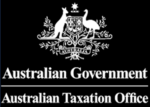
March 2019: ATO – Risk assessment of inbound distribution arrangements
The Guideline outlines ATO’s compliance approach to the transfer pricing outcomes associated with the following activities of inbound distributors: distributing goods purchased from related foreign entities for resale, and distributing digital products or services where the intellectual property in those products or services is owned by related foreign entities Such activities, together with any related activities involving the provision of ancillary services, are referred to in this Guideline as ‘inbound distribution arrangements’. This Guideline applies to inbound distribution arrangements of any scale. The framework in the Guideline is used to assess the transfer pricing risk of inbound distribution arrangements and tailor our engagement with you. Where this Guideline applies, we rate the transfer pricing risk of your inbound distribution arrangements having regard to a combination of quantitative and qualitative factors. If an inbound distribution arrangements fall outside the low transfer pricing risk category, the transfer pricing outcomes of the arrangements can be expected to be monitor, tested and/or verified. The framework set out in the Guideline can be used to: assess the transfer pricing risk of inbound distribution arrangements understand the compliance approach given the transfer pricing risk profile of the inbound distribution arrangements mitigate the transfer pricing risk of the inbound distribution arrangements Structure of the Guideline The Guideline is structured as follows: the main body sets out general principles relevant to our framework for assessing transfer pricing risk and applying compliance resources to inbound distribution arrangements to which the Guideline applies, and the schedules set out quantitative and qualitative indicators relevant to distributors generally or based on their industry sector, including those that operate in the life science, information and communication technology (ICT) and motor vehicle industries. This Guideline does not provide advice or guidance on the technical interpretation or application of Australia’s transfer pricing rules or other tax provisions.

Pharma and Tax Avoidance, Report from Oxfam
New Oxfam research shows that four pharmaceutical corporations — Abbott, Johnson & Johnson, Merck, and Pfizer — systematically allocate super profits in overseas tax havens. In eight advanced economies, pharmaceutical profits averaged 7 percent, while in seven developing countries they averaged 5 percent. In comparison, profits margins averaged 31 percent in countries with low or no corporate tax rates – Belgium, Ireland, Netherlands and Singapore. The report exposes how pharmaceutical corporations uses sophisticated tax planning to avoid taxes.
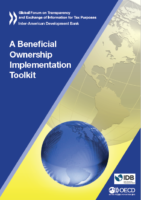
May 2019: New Beneficial Ownership Toolkit will help tackle tax evasion
A beneficial ownership toolkit was released 20. May 2019 in the context of the OECD’s Global Integrity and Anti-Corruption Forum. The toolkit, prepared by the Secretariat of the OECD’s Global Forum on Transparency and Exchange of Information for Tax Purposes in partnership with the Inter-American Development Bank, is intended to help governments implement the Global Forum’s standards on ensuring that law enforcement officials have access to reliable information on who the ultimate beneficial owners are behind a company or other legal entity so that criminals can no longer hide their illicit activities behind opaque legal structures. The toolkit was developed to support Global Forum members and in particular developing countries because the current beneficial ownership standard does not provide a specific method for implementing it. The toolkit covers a variety of important issues regarding beneficial ownership, including: the concepts of beneficial owners and ownership, the criteria used to identify them, the importance of the matter for transparency in the financial and non-financial sectors; technical aspects of beneficial ownership requirements, distinguishing between legal persons and legal arrangements (such as trusts), and measures being taken internationally to ensure the availability of information on beneficial ownership a series of checklists that may be useful in pursuing a specific beneficial ownership framework; ways in which the principles on beneficial ownership can play out in practice in Global Forum EOIR peer reviews; why beneficial ownership information is also a crucial component of the automatic exchange of information regimes being adopted by jurisdictions around the world.

March 2019: EU report on financial crimes, tax evasion and tax avoidance
In March 2018 a special EU committee on financial crimes, tax evasion and tax avoidance (TAX3) was established. Now, one year later, The EU Parliament has approved a controversial report from the committee. According to the report close to 40 % of MNEs’ profits are shifted to tax havens globally each year with some European Union countries appearing to be the prime losers of profit shifting, as 35 % of shifted profits come from EU countries. About 80 % of the profits shifted from EU Member States are channelled to or through a few other EU Member States. The latest estimates of tax evasion within the EU point to a figure of approximately EUR 825 billion per year. Tax avoidance via six EU Member States results in a loss of EUR 42,8 billion in tax revenue in the other 22 Member States, which means that the net payment position of these countries can be offset against the losses they inflict on the tax base of other Member States. For instance, the Netherlands imposes a net cost on the Union as a whole of EUR 11,2 billion, which means the country is depriving other Member States of tax income to the benefit of multinationals and their shareholders. The Commission has criticised seven Member States – Belgium, Cyprus, Hungary, Ireland, Luxembourg, Malta and the Netherlands – for shortcomings in their tax systems that facilitate aggressive tax planning, arguing that they undermine the integrity of the European single market. Member States now calls on the Commission to currently regard at least these five Member States as EU tax havens until substantial tax reforms are implemented.

Transfer Pricing in the Mining Industry
Like other sectors of the economy, there are base erosion and profit shifting risks in the mining sector. Based on the ongoing work on BEPS, the IGF (Intergovernmental Forum on Mining) and OECD has released guidance for source countries on transfer pricing in the mining sector. The transfer pricing and tax avoidance issues identified in the sector are: 1. Excessive Interest Deductions Companies may use related-party debt to shift profit offshore via excessive interest payments to related entities. “Debt shifting” is not unique to mining, but it is particularly significant for mining projects that require high levels of capital investment not directly obtainable from third parties, making substantial related-party borrowing a frequent practice. 2. Abusive Transfer Pricing Transfer pricing occurs when one company sells a good or service to another related company. Because these transactions are internal, they are not subject to market pricing and can be used by multinationals to shift profits to low-tax jurisdictions. Related-party transactions in mining can be broadly grouped into two categories: (1) the sale of minerals and/or mineral rights to related parties; and (2) the purchase or acquisition of various goods, services and assets from related parties. Developing countries require sector-specific expertise to detect and mitigate transfer mispricing in the mining sector. 3. Undervaluation of Mineral Exports Profit shifting via the pricing of mineral products sold to related parties is a major concern for many mineral exporting countries. For developing countries, these risks are elevated where government agencies lack the mineral-testing facilities required to verify the grade and quality of mineral exports, as well as detailed sector-specific knowledge of the mining transformation process and mineral product pricing. 4. Harmfull Tax Incentives Mining and exploration tax incentives are common in developing countries. While tax incentives could encourage expansion of the sector, they may also lead to excess transfers of the gains from countries. It is unrealistic to expect that developing countries will forego incentives entirely due to the pressures of attracting investment. However, it is important that countries understand when tax incentives may be appropriate, how companies are likely to respond to incentives, and the distinction between tax incentives that permanently reduce taxes and from provisions affecting timing impacts. 5. Tax Stabilisation Clauses Fiscal stabilization clauses are problematic from a tax perspective because they can freeze the fiscal terms in the contract such that changes in tax law may not be applicable to existing mines, foregoing significant government revenue. 6. International Tax Treaties Developing countries consistently raise concerns about tax treaty abuse. Countries with abundant mineral resources need particular assistance in this area, considering how treaty provisions might have a significant impact on taxes imposed on the mining sector. 7. Offshore Indirect Transfers of Mining Assets Transfers of ownership of company assets (or the companies themselves) can generate significant income, which many countries seek to tax as capital gains. Transactions may be structured to fall outside the mining country’s tax base by selling shares in an offshore company holding the asset, without notifying tax authorities in the country where the asset/company is located. 8. Metals Streaming Metals streaming involves mining companies selling a certain percentage of their production at a fixed cost to a financier in return for funds for partial or complete mine development and construction. Since the amount of financing provided is linked to the discounted mineral price, companies have strong incentives to agree to lower fixed prices to increase the up-front finance available. Streaming reduces the tax base of resource-producing countries, where royalties and income tax use sales revenue as part of calculations. There is virtually no guidance on these arrangements in the mining tax literature. 9. Abusive Hedging Arrangements Hedging is a legitimate business practice in many commodity markets. It consists of locking in a future-selling price in order for both parties to the transaction to plan their commercial operations with predictability. A problem arises when companies engage in abusive hedging with related parties. They use hedging contracts to set an artificially low sale price for production and therefore record systematic hedging losses, reducing their taxable income. 10. Inadequate Ring-Fencing It is possible that mining companies will have multiple activities within a country, creating opportunities to use losses incurred in one project (e.g., during exploration for a new mine), to offset profits earned in another project, thereby delaying payment of corporate income tax. Ring-fencing is one way of limiting income consolidation for tax purposes; however, getting the design right is critical to securing tax revenues while attracting further investment. The following reports adresses some of these issues: Limiting the impact of Excessive Interest Deductions on Mining Revenue Tax incentives in Mining: Minimising risk to Revenue Comparables Data for Transfer Pricing Analyses – Prices of Minerals Sold in an Intermediate Form Toolkit for Transfer Pricing Risk Assessment in the African Mining Industry Transfer Pricing Cases in Mining and Commodity Case NameDescriptionDateCourtCatagoriesKeywords

April 2019: UN Manual – Financial Transactions and Profit Splits
A new version of the UN Practical Manual on Transfer Pricing for Developing Countries is due by 2021. According to the mandate the new manual will make further improvements in usability and practical relevance, updates and improvements to existing text, including on Country Practices (Part D) and will have new content, in particular, on financial transactions; profit splits, centralized procurement functions and comparability issues. A draft paper was published 8 April 2019 containing further guidance on: • Financial Transactions (Attachment A); • Profit Splits (Attachment B); and • Establishing Transfer Pricing Capability, Risk Assessment and Transfer Pricing Audits (Attachment C).

The Australian Taxation Office and Mining Giant BHP have settled an ongoing Transfer Pricing Dispute
The Australian Taxation Office has agreed on a settlement with BHP Mining Group to resolve a transfer pricing dispute relating to transfer pricing treatment of commodities sold to a Singapore marketing hub. BHP had originally been assessed with over AUD 1 billion in additional taxes. According to the settlement BHP will pay additional tax of AUD 529 million to resolve the dispute, covering the years 2003–18. According to the settlement BHP Group will also increase its ownership of BHP Billiton Marketing AG, the company conducting BHP’s Singapore marketing business, from 58 percent to 100 percent. The change in ownership will result in all profits made in Singapore in relation to the Australian assets owned by BHP Group being fully subject to Australian tax. BHP’s Singapore marketing arrangements will continue to be located in Singapore and will also be within the ‘low risk’ segment for offshore marketing hubs.

2018: ATO Taxpayer Alert on Mischaracterisation of activities or payments in connection with intangible assets (TA 2018/2)
The ATO is currently reviewing international arrangements that mischaracterise intangible assets[1] and/or activities or conditions connected with intangible assets. The concerns include whether intangible assets have been appropriately recognised for Australian tax purposes and whether Australian royalty withholding tax obligations have been met. Arrangements that allocate all consideration to tangible goods and/or services, arrangements that allocate no consideration to intangible assets, and arrangements that view intangible assets collectively, or conceal intangible assets, may be more likely to result in a mischaracterisation. Where arrangements are between related parties, we are concerned about whether the: amount deducted by the Australian entity under the arrangement meets the arm’s length requirements of the transfer pricing provisions in the taxation law[2] functions performed, assets used and risked assumed by the Australian entity, in connection with the arrangement, are appropriately compensated in accordance with the arm’s length requirements of the transfer pricing provisions in the taxation law. These arrangements typically display most, if not all, of the following features: intangible assets are developed, maintained, protected or owned by an entity located in a foreign jurisdiction (an ‘IP entity’) the Australian entity enters into an arrangement to undertake an activity or a combination of activities the Australian entity requires the use of the relevant intangible assets in order to undertake these activities the Australian entity purchases goods and/or services from an IP entity or a foreign associate of an IP entity in order to undertake these activities the Australian entity agrees to pay an amount, or a series of amounts, to a foreign entity which the Australian entity does not recognise or treat as wholly or partly being for the use of an IP entity’s intangible assets. This Taxpayer Alert (Alert) does not apply to international arrangements which involve an incidental use of an intangible asset. For example, this Alert does not apply to resellers of finished tangible goods where the activity of reselling the goods involves an incidental use of a brand name that appears on the goods and related packaging. Whether a use is incidental in this sense will depend on an analysis of the true relationship and activities of the parties. The fact that an arrangement fails to expressly provide for the use of an intangible asset does not, in itself, determine that a use is incidental.
Analog Devices hit by $52m tax demand in Ireland
Analog Devices has been issued a $52m tax demand from the Revenue Commissioners in Ireland. The assessment is related to inter-company transfers back in 2013, where – according to the tax authorities – the Irish entity has failed to conform to OECD transfer pricing guidelines. Analog Devices specialises in data converters and chips that translate a button press or sound – into electronic signals. The company was established in Ireland in 1977, where today about 1,200 people is employed at its original and main hub in Limerick, in addition to its design facility in Cork. Analog Devises 10K filing “The Company has numerous audits ongoing at any time throughout the world, including an Internal Revenue Service income tax audit for Linear’s pre-acquisition fiscal 2015 and fiscal 2016, various U.S. state and local tax audits, and transfer pricing audits in Spain, the Philippines and Ireland. With the exception of the Linear pre-acquisition audit, the Company’s U.S. federal tax returns prior to fiscal year 2015 are no longer subject to examination. All of the Company’s Ireland tax returns prior to fiscal year 2013 are no longer subject to examination. During the fourth quarter of fiscal 2018, the Company’s Irish tax resident subsidiary received an assessment for fiscal 2013 of approximately €43.0 million, or $52.0 million (as of November 3, 2018), from the Irish Revenue Commissioners. This assessment excludes any penalties and interest. The assessment claims that the Company’s Irish entity failed to conform to 2010 OECD Transfer Pricing Guidelines. The Company strongly disagrees with the assessment and maintains that its transfer pricing is appropriate. Therefore, the Company has not recorded any additional tax liability related to the 2013 tax year or any other periods. The Company intends to vigorously defend its originally filed tax return position and has filed an appeal with the Irish Tax Appeals Commission, which is the normal process for the resolution of differences between Irish Revenue and taxpayers. If Irish Revenue were ultimately to prevail with respect to its assessment for the tax year 2013, such assessment and any potential impact related to years subsequent to 2013 could have a material unfavorable impact on the Company’s income tax expense and net earnings in future periods. The tax returns for Linear Technology Pte. Ltd. (Singapore) prior to the fiscal 2018 are no longer subject to examination by the Economic Development Board pursuant to terms of the tax holiday re-negotiation. Although the Company believes its estimates of income taxes payable are reasonable, no assurance can be given that the Company will prevail in the matters raised or that the outcome of one or all of these matters will not be different than that which is reflected in the historical income tax provisions and accruals. The Company believes such differences would not have a material impact on the Company’s financial condition.“ According to the 10K filing Analog Devises is present in numerous well known low-tax jurisdictions. “Non-U.S. jurisdictions accounted for approximately 75.9% of our total revenues for fiscal 2018, compared to approximately 77.3% of our total revenues fiscal 2017. This revenue generated outside of the U.S. results in a material portion of our pretax income being taxed outside the U.S., primarily in Bermuda, Ireland and Singapore, at tax rates ranging from 0% to 33.3%. We have a partial tax holiday in Malaysia through July 2025. A partial tax holiday in Singapore had been in place through August 2019, but was terminated effective September 2018 due to negotiations with the Economic Development Board. The aggregate dollar benefits derived from these tax holidays approximated $27.7 million and $27.4 million in fiscal 2018 and 2017, respectively. The impact of the tax holidays during fiscal 2018 increased the basic and diluted net income per common share by $0.07 each. The impact of the tax holidays during fiscal 2017 increased the basic and diluted net income per common share by $0.08 each. The impact on our provision for income taxes on income earned in foreign jurisdictions being taxed at rates different than the U.S. federal statutory rate was a benefit of approximately $434.8 million and a foreign effective tax rate of approximately 7.4% for fiscal 2018, compared to a benefit of approximately $385.1 million and a foreign effective tax rate of approximately 7.8% for fiscal 2017. A reduction in the ratio of domestic taxable income to worldwide taxable income effectively lowers our overall tax rate, due to the fact that the tax rates in the majority of foreign jurisdictions.“
The Australian Taxation Office and Bupa Health Insurance reaches $157m settlement after decade-long dispute
Bupa reaches $157m settlement with the Australian tax office after decade-long dispute The settlement was the result of a decade-long dispute with the ATO over a “number of different matters”, included transfer pricing issues with acquisitions in Australia in 2007 and 2008. Bupa’s tax affairs came under scrutiny last year in a report by the Tax Justice Network. The report alleged that Bupa frequently used related party loans and debts from a corporate restructure, among other things, to reduce its profits in Australia. According to the report, Bupa posted a total income of $7.5bn in Australia in 2015-16, but paid just $105m in tax on a taxable income of $352m. Its aged care business in Australia made more than $663m, about 70% of which was from government funding. At the time of the report’s release, Bupa denied it had breached any tax laws.

March 2019: EU list of Non-Cooperative Tax Jurisdictions – Tax Havens
12 March 2019 the EU Council added ten jurisdictions to the list of Non-Cooperative Tax Jurisdictions – Tax Havens. Non-Cooperative Tax Jurisdictions are those that refused to engage with the EU or to address tax good governance shortcomings. As of March 2019 the EU list of Non-Cooperative Tax Jurisdictions includes 15 countries: American Samoa Barbados Guam Samoa Trinidad and Tobago US Virgin Islands Aruba Belize Bermuda Dominica Fiji Marshall Islands Oman United Arab Emirates Vanuatu
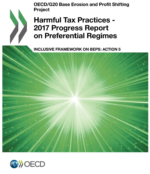
Preferential Tax Regimes – Harmful Tax Practices
On 13 November 2018, the Inclusive Framework on BEPS approved updates to the results of reviews of preferential tax regimes conducted in connection with BEPS Action 5. The data below presents the conclusions of the work on regime reviews. The results are a consolidated update of the regimes reported in Harmful Tax Practices – 2017 Progress Report on Preferential Regimes. Countries with harmfull tax practices – preferential tax regimes – are defined based on the following factors: Where no or low effective tax rates (or negotiable tax rates or bases) are imposed on income from highly mobile assets and activities Where the low tax regime is ring-fenced (separated) from the domestic economy Where there is no transparancy and no exchange of information with other jurisdictions, eg. secrecy provisions Where there is no requirement of substantial economic activities/substance The Inclusive Framework on BEPS has decided to resume the application of the substantial activities requirement for no or only nominal tax jurisdictions. Originally a criteria set out in the harmful tax framework from 1998, it had not been applied to date. However, with the elevation of the substantial activities requirements in preferential regimes, and the broad-based membership of the Inclusive Framework working together on an equal footing, it was considered the right time to ensure that equivalent substance requirements apply in no or only nominal tax jurisdictions. This global standard means that mobile business income cannot be parked in a zero tax jurisdiction without the core business functions having been undertaken by the same business entity, or in the same location. In doing so, the Inclusive Framework will ensure that substantial activities must be performed in respect of the same types of mobile business activities, regardless of whether they take place in a preferential regime or in a no or only nominal tax jurisdiction.
Western Digital in $549 million transfer pricing dispute with the IRS
Western Digital has been issued a $549 million tax assessment for fiscal years 2008 – 2012 by the IRS relating to transfer pricing with the Company’s foreign subsidiaries and intercompany payable balances. In the Annual Report for 2018 the following is stated by Western Digital on the case: “The Internal Revenue Service (“IRS”) previously completed its field examination of the Company’s federal income tax returns for fiscal years 2008 through 2012 and proposed certain adjustments. As previously disclosed, the Company received Revenue Agent Reports from the IRS for fiscal years 2008 through 2009, proposing adjustments relating to transfer pricing with the Company’s foreign subsidiaries and intercompany payable balances. The Company disagrees with the proposed adjustments and in September 2015, filed a protest with the IRS Appeals Office and received the IRS rebuttal in July 2016. The Company and the IRS Appeals Office did not reach a settlement on the disputed matters. On June 28, 2018, the IRS issued a statutory notice of deficiency with respect to the disputed matters for fiscal years 2008 through 2009, seeking to increase the Company’s U.S. taxable income by an amount that would result in additional federal tax through fiscal year 2009 totaling approximately $516 million, subject to interest. The Company filed a petition with the U.S. Tax Court in September 2018. On December 10, 2018, the IRS issued a statutory notice of deficiency with respect to fiscal years 2010 through 2012, seeking to increase the Company’s U.S. taxable income by an amount that would result in additional federal tax for fiscal years 2010 through 2012 totaling approximately $549 million, subject to interest. Approximately $535 million of the total additional federal tax relates to proposed adjustments for transfer pricing with the Company’s foreign subsidiaries, intercompany payable balances and the utilization of certain tax attributes. The Company plans to file a petition with the U.S. Tax Court by March 2019. The Company believes that its tax positions are properly supported and will vigorously contest the position taken by the IRS.”

Poland issues Tax Explanations on Transfer Pricing – No. 1: Comparability Analyses and Transfer Pricing Documentation
18 June 2019 the Polish Minister of Finance issued the first explanations on transfer pricing concerning – technical aspects of preparing comparability analyses and transfer pricing documentation. With regard to the technical aspects of preparing comparability analyses, the explanations cover such detailed issues as: data comparability vs. locality feasibility of using internal data feasibility of using bid data the appropriateness of using comparables that are not publicly available (so-called secret comparables) reasonableness of discarding from the comparables sample entities with extreme results (including those with loss) minimum sample size for benchmark data analysis selection of an interval point updating the benchmark data analysis. The second key issue addressed by the explanatory notes is the preparation of descriptions of the consistency of the terms of transactions and other events agreed with related parties with the terms that would be agreed among independent parties. Click here for unofficial English translation

The Australian Taxation Office and Mining Giant BHP have settled yet another Transfer Pricing Dispute
BHP Group has agreed to pay the state of Western Australia A$250 million to end a dispute over royalties paid on iron ore shipments sold through its Singapore marketing hub. The State government found in January that the world’s biggest miner had underpaid royalties on iron ore shipments sold via Singapore stretching back over more than a decade. BHP reached a deal to pay A$529 million in additional taxes to the Australian government late last year to settle a long-running tax dispute over the miner’s Singapore hub on its income from 2003-2018.
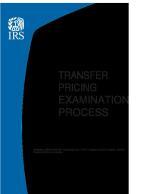
June 2019: IRS Transfer Pricing Examination Process – Risk Assessment
The report on Transfer Pricing Examination Process (TPEP) provides a framework and guide for transfer pricing examinations. The guide will be updated regularly by the IRS based on feedback from examiners, taxpayers, practitioners and others.
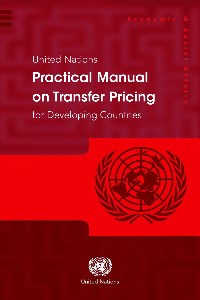
2019 Update-UN-Practical-Manual-on-Transfer-Pricing
On 8 April 2019 the UN subcommittee issued it’s first discussion draft on the future updates to the UN Practical-Manual-on-Transfer-Pricing on Financial transactions, BEPS consistency and Risk Assessment and Audit practices. Attachment A: the proposed new Chapter B on Financial Transactions. The draft discusses the importance of corporate financing decisions within multinational groups and how those decisions could lead to tax base The Chapter discusses interaction with rules and measures against base erosion; common types of intra- group financial transactions and of group financing departments; the process of actual delineation and relevant characteristics of financial transactions; the process and system of credit rating; potential transfer pricing methods, including the use of simplification measures/safe harbours; different types of intra group loans and relevant characteristics; determining the arm’s length nature of intra-group loans; different types of intra group financial guarantees and relevant characteristics; determining the arm’s length nature of intra-group financial guarantees; and available methods. The chapter also discusses cash pooling practices and captive insurance, without getting into further detail on the delineation and arm’s length pricing of those specific transactions. Different types of intra-group loans are mentioned, and the draft identifies four steps to determine the arm’s length nature of intra-group loans: (i) analyse economically relevant characteristics; (ii) accurately delineate the entire transaction undertaken as well as (iii) selection and (iv) application, of the most appropriate transfer pricing method. The Subcommittee has not yet discussed any of the examples in shaded text and comments are therefore not invited for discussion at this Session of the Committee. Attachment B: Revision to the guidance contained in the Manual on the transactional profit-split method (Chapter 3.3.) with the main focus being on seeking consistency of this guidance with the work done in the context of the Inclusive Framework on BEPS, while providing more practical examples. The draft includes the existing text side-by-side with the proposed revisions for better understanding. The draft is ready for Committee consideration, with one exception. Shaded text, such as on the use of “hindsight”, will need further Subcommittee discussion before a draft is ready for Committee consideration and comments are therefore not invited for discussion at this Session of the Committee. Attachment C: A progress draft of the work on sections C.2. Establishing Transfer Pricing Capability in Developing Countries (previously C.5.); C.4. Risk Assessment (Previously part of C.3.) and C.5. Transfer Pricing Audits. The purpose is mainly to streamline the sequences of presentation and to eliminate overlaps in the current
Telenor will have to pay additional taxes of 2.5 billion Norwegian crowns
Telenor Norway has received a tax assessment according to which the company will have to pay additional taxes in Norway of 2.5 billion Norwegian crowns for tax year 2013. A deduction expenced in 2013 for a loss suffered in 2012 due to settlement of bank guarantees given in respect of external funding in its Indian subsidiary Unitech Wireless has been disallowed for tax purposes by the Norwegian Tax Authorities Telenor decided to enter the market in India in 2008. In 2012, the Supreme Court of India revoked the licenses of the Telenor mobile company and seven other mobile companies. In the fall of 2012, Telenor paid around NOK 4.2 billion to buy back licenses in six of 22 telecommunications regions. Following a dispute with Telenor’s Indian partnership – Unitech – the parties agreed to transfer all the valuables of their joint unit company Mobile Unitech Wireless to a Telenor-controlled company – Telenor India. In the annual report for 2018, Telenor Norway writes that in 2012 the company recognized claims against Unitech Wireless after the company released its guarantee of NOK 10.6 billion for all interest-bearing debt in Unitech Wireless . – deferred tax asset of 2.5 billion Norwegian kroner has been recognized. In 2013, the business transfer from Unitech Wireless to Telenor India was completed and Telenor ASA deducted NOK 9.3 billion as a tax loss in its tax returns. Telenor later withdraw from the Indian market after losses in total of 25 billion.
The L’Oréal group announced additional payment of 320 million euros in corporate tax to the French tax authorities to “settle a dispute”
The French cosmetic group L’Oréal announced in September 2019 that it would pay 320 million euros to the French tax authorities to “settle a dispute” related to the payment of corporate tax for three of its subsidiaries for fiscal years 2014 and 2018. In detail, the charge was 47 million euros for Lancôme Parfums et Beauté, 115 million euros for Active International Cosmetics and 158 million euros for Prestige and Collections International.

2019: ATO draft on compliance approach to the arm’s length debt test
The draft Guideline provides guidance to entities in applying the arm’s length debt test in Division 820 of the Income Tax Assessment Act 19972 and should be read in conjunction with draft Taxation Ruling TR 2019/D2 Income tax: thin capitalisation – the arm’s length debt test. This Guideline also provides a risk assessment framework that outlines our compliance approach to an application of the arm’s length debt test in certain circumstances that are identified as low risk. The arm’s length debt test is one of the tests available to establish an entity’s maximum allowable debt for thin capitalisation purposes. The test focuses on identifying an amount of debt a notional stand-alone Australian business would reasonably be expected to borrow, and what independent commercial lenders would reasonably be expected to lend on arm’s length terms and conditions. An entity’s debt deductions are reduced to the extent that its adjusted average debt exceeds its maximum allowable debt. The arm’s length debt test may be used to support debt deductions for commercially justifiable levels of debt. In practice, the test is typically only used when an entity is unable to satisfy the safe harbour and worldwide gearing tests (as the compliance burden of applying these tests is generally lower). It is not common for Australian businesses to gear in excess of 60% of their net assets and historically relatively few entities have applied the arm’s length debt test. We consider the choice to apply the arm’s length debt test carries with it the necessity to undertake more rigorous analysis than the safe harbour and worldwide gearing tests. While the arm’s length debt test in some respects draws upon arm’s length concepts that are broadly common to transfer pricing, the test itself is not a transfer pricing analysis, nor does it necessarily proxy an outcome consistent with the arm’s length conditions under Subdivision 815-B. Rather it requires an overlay of factual assumptions that produce a hypothetical entity against which specific factors are to be assessed. This Guideline is limited to providing guidance and a risk assessment framework relating to the application of the arm’s length debt test contained in sections 820-105 and 820-215. It does not set out our approach to reviewing other taxation issues that might arise in relation to debt deductions.
Malaysian Energy Group – TENAGA Nasional Bhd – has been issued a RM 4.000.000.000 tax bill by the Revenue Board of Malaysia
Malaysian Energy Group – TENAGA Nasional Bhd – has begun legal proceedings against the Inland Revenue Board of Malaysia. In November 2019, the Inland Revenue Board issued a tax assessment according to which taxes of RM3.98 bil (or USD 1 billion) is owed for years 2015-2017. After reciving the assessment, TENAGA responded “Based on the legal advice obtained from our tax solicitors, TNB has a good basis to contend that there is no legal and factual basis for IRB to issue the said notices” “Accordingly, TNB will be appealing against the said notices.” The High Court has now granted an interim stay of all further proceedings including the enforcement of the notices until the hearing of the leave application on April 2, 2020. In a prior case back from 2015 TENAGA received notices for the years of assessment 2013 and 2014 amounting to RM2.07 bil. Back then, TANAGA responded in the same way and said it would be “appealing against the said notices and the appeal process has commenced.” This prior dispute was later settled when Tenaga opted for an appeal to the Special Commissioners of Income Tax (SCIT) to qualify for a “reinvestment allowance”.
Unilateral Measures related to taxation of the Digital Economy
Imposed and proposed unilateral measures to adress taxation of the Digital Economy TPG 1979 SearchMore results...
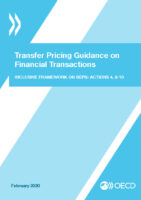
New TPG Chapter X on Financial Transactions (and additions to TPG Chapter I) released by OECD
In February 2020, OECD released the report Transfer Pricing Guidance on Financial Transactions. The guidance in the report describes the transfer pricing aspects of financial transactions and includes a number of examples to illustrate the principles discussed in the report. Section B provides guidance on the application of the principles contained in Section D.1 of Chapter I of the OECD Transfer Pricing Guidelines to financial transactions. In particular, Section B.1 of this report elaborates on how the accurate delineation analysis under Chapter I applies to the capital structure of an MNE within an MNE group. It also clarifies that the guidance included in that section does not prevent countries from implementing approaches to address capital structure and interest deductibility under their domestic legislation. Section B.2 outlines the economically relevant characteristics that inform the analysis of the terms and conditions of financial transactions. Sections C, D and E address specific issues related to the pricing of financial transactions (e.g. treasury functions, intra-group loans, cash pooling, hedging, guarantees and captive insurance). This analysis elaborates on both the accurate delineation and the pricing of the controlled financial transactions. Finally, Section F provides guidance on how to determine a risk-free rate of return and a risk-adjusted rate of return. Sections A to E of this report are included in the OECD Transfer Pricing Guidelines as Chapter X. Section F is added to Section D.1.2.1 in Chapter I of the Guidelines, immediately following paragraph 1.106.
Facebook France has agreed to pay 106 million euros in back taxes and penalties
The agreement, according to which Facebook France will pay 106 million euros in back taxes and penalties, was reached after French tax authorities had carried out an extensive audit covering FY 2009-2018. Furthermore, Facebook’s French revenues were increased last year after the company decided to include advertising income from French companies in its local accounts, instead of declaring them in Ireland, where Facebook’s international operations are based. As a result, Facebook will pay 8.4 million euros in taxes in France this year – 50% more than last year. These changes are likely the result of efforts from the French government to have global online businesses pay more taxes locally.
Mining Group Rio Tinto in new $86 million Dispute with ATO over pricing of Aluminium
In March 2020 the Australian Taxation Office issued an tax assessment regarding transfer pricing to Rio Tinto’s aluminium division according to which additional taxes in an amount of $86.1 million must be paid for fiscal years 2010 – 2016. According to the assessment Rio’s Australian subsidiaries did not charge an arm’s length price for the aluminium they sold to Rio’s Singapore marketing hub. This new aluminum case is separate to Rio’s long-running $447 million dispute with the ATO over the transfer pricing of Australian iron ore. Rio intents to object to the ATO’s aluminium claim and states that the pricing of iron ore and aluminium has been determined in accordance with the OECD guidelines and Australian and Singapore domestic tax laws.
Fiat Chrysler reaches a EUR 2.5 billion settelment with the Italien tax authorities
Fiat Chrysler has reached a settlement with the Italian tax agency over taxable gains related to a transfer of the U.S. Chrysler business from Fiat SpA Italy to Fiat Chrysler Automobiles NV (Netherlands). The Italian tax agency claimed that the value of the U.S. Chrysler business had been underestimated and issued a preliminary assessment with an additional taxable gain of 5.1 billion euros. The agency had valued Chrysler at 12.5 billion euros, while Fiat SpA had declared it to be worth less than 7.5 billion. Under the terms of the latter settlement the additional taxable gain has agreed at 2.5 billion euros.

2020: ATO Alert on arrangements and schemes connected with DEMPE of intangibles
The ATO is currently reviewing international arrangements that mischaracterise Australian activities connected with the development, enhancement, maintenance, protection and exploitation (DEMPE) of intangible assets. Such arrangements may be non-arm’s length or structured to avoid tax obligations, resulting in inappropriate outcomes for Australian tax purposes. One of the issues is whether functions performed, assets used and risks assumed by Australian entities in connection with the DEMPE of intangible assets are properly recognised and remunerated in accordance with the arm’s length requirements of the transfer pricing provisions in the taxation law. These arrangements are particularly in focus where intangible assets and/or associated rights are migrated to international related parties as part of non-arm’s length arrangements and/or in a manner intended to avoid Australian tax. In circumstances where these arrangements lack evidence of commercial rationale and/or substance, the ATO will apply of the exceptions in the transfer pricing provisions (non-recognition) and anti-avoidance rules. The general anti-avoidance rule (GAAR) or diverted profits tax (DPT) provisions may apply where a tax benefit or DPT tax benefit is obtained in connection with these arrangements. Arrangements of particular concern include, but are not limited to, those described in the Alert.

Korean tax authorities investigates Starbucks’ pricing of coffee beans
Starbucks Korea is now being investigated for overpricing goods and services imported from abroad. Officials from the National Tax Service have seized accounting records and data held at Starbucks’ Korean head office in Seoul. Subject of the investigation is transfer pricing of coffee beans and others products for sale at its more than 1,370 local shops. In 2019 Starbucks Korea reported sales of over 1.87 trillion won ($1.53 billion) and net profits of 132.8 billion won.
New German Administrative Ordinance on transfer pricing issues AO 2020, DOK 2020/1174240
In december 2020 the Federal Ministry of Finance in German issued a new administrative ordinance related to various transfer pricing issues. Among the issues are enhanced requirement to cooperate and submit additional documentation related to controlled transactions, but most notable may be the conditions under which estimated tax assessments can be issued. Below is an unofficial translation of the document. Click here for the original document
Peru – report on use of the most appropriate method to determine the market value of services
In december 2020 the tax authorities in Peru issued a new administrative ordinance related to use of the most appropriate method to determine the market value of services. Click here for English translation
Mining Company Oyu Tolgoi LLC receives a second Tax Assessment from the Mongolian Tax Authority
The Oyu Tolgoi copper-gold mine is a joint venture between Turquoise Hill Resources (which is 50.8 per cent owned by Rio Tinto), and the Mongolian Government. The Mongolian government has not been satisfied by the result of the joint venture and has concerns that increasing development costs of the Oyu Tolgoi project has eroded the economic benefits it anticipated receiving. “It is calculated that Mongolia will not receive dividend payments until 2051 and will incur debts of US$22 billion,” said Mongolia’s deputy chief cabinet secretary, Solongoo Bayarsaikhan. “In addition, Oyu Tolgoi is estimated to pay profit taxes or corporate income taxes only in four years until 2051.” The Mongolian authorities has put forward proposals to coordinate and lower management services received from Rio Tinto and increase Mongolia’s benefits by reducing shareholder loan interest rates. On December 23, 2020 the Mongolian Tax Authority issued a press release concerning the results of a completed transfer pricing audit of Oyu Tologi LLC. “The Mongolian Tax Authority has recently completed an audit of Oyu Tolgoi LLC’s 2016-2018 tax returns and identified a number of violations and breaches of relevant laws and the International Rules. As a result, Oyu Tolgoi LLC was notified of MNT 649.4 billion (approximately US$228 million) of additional taxes, inclusive of penalty and default interests, that are due to be paid in cash to the Government of Mongolia. In addition, the MTA has reduced Oyu Tolgoi LLC’s operating loss carry forward balance by MNT 3.4 trillion (approximately US$ 1.2 billion). The Mongolian Tax Authority concluded that certain transactions between Oyu Tolgoi LLC and Rio Tinto and its affiliates were not done at an arm’s length basis and were in violation of the International Rules. Accordingly, the value of such transactions was adjusted, for tax purposes, to reflect the actual value that would have been paid had the transactions occurred between unrelated parties dealing at an arm’s length basis. Major adjustments were made to a series of transactions between Oyu Tolgoi LLC and affiliated entities of Rio Tinto whereby economic value was transferred.” The 2016-2018 audit of Oyu Tologi LLC follows up on a previous assessment for FY 2013-2015. According to an announcement from Turquoise Hill Resources, the previous assessment has now been referred to international arbitration.
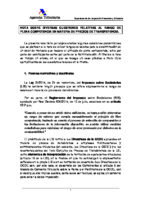
Spain releases note on arm’s length range and benchmarking.
On 25 February 2021, a note was released by the Spanish Tax Agency on number of practical issues relating to application of the arm’s-length range. The note – which is based on the OECD transfer Pricing Guidelines, guidance on benchmark studies issued by the Joint Transfer Pricing Forum, and relevant Spanish case laws – answers the following questions – How is the range of values determined? – Is it possible to determine a range of values in which the figures are relatively equally reliable? – How to proceed if a range is determined in which all figures are not relatively equally reliable? – When should statistical tools be used to narrow the range? – What should be done if there is a wide dispersion in the range? – Where in the range should the value of the linked transactions be selected? – When can the administration adjust the values used by the taxpayer in its controlled transactions covered by a range of values? The note concludes that – Any transfer pricing adjustment requires justification that the value declared by the taxpayer does not comply with the arm’s length principle. – While in some cases it will be possible to determine a single figure as a more reliable benchmark to establish whether a transaction is at arm’s length, in many cases the application of the most appropriate valuation method will lead to a range of figures. – In determining a range of arm’s length values, those transactions with a lower degree of comparability should be eliminated. Also, to the extent that comparability can be improved and where possible, comparability adjustments should be made for those values that require them. However, it is common for a lack of information to prevent such adjustments from being made. – A range of values with a wide dispersion is often indicative of comparability defects in the values that determine the range and should lead to a more detailed analysis. – After such refinements, a range of values could be obtained in which all results are very reliable and relatively equal. In this case, any point in the range complies with the arm’s length principle and therefore no adjustment is appropriate if the value reported by the taxpayer is within the range. If it is outside the range, the adjustment will take the value of the controlled transaction to the value that is closest within the range. – In practice, the range will usually not comprise very reliable and relatively equal results. In this case, once the least comparable results have been eliminated, if there are still defects in comparability that cannot be identified or quantified (and therefore cannot be adjusted for), statistical tools are commonly used which, while not eliminating these defects in comparability, improve the reliability of the analysis. This is achieved by narrowing the range by using only those values between the 1st and 3rd quartiles. – In this case, if the value declared by the taxpayer is within the arm’s length range (whether declared by the taxpayer and accepted by the government or determined by the government), no adjustments should be made. – If, on the other hand, the value declared by the taxpayer is outside the range, the adjustment should generally be made to the median. This is unless, as expressly stated in EU doctrine, after a thorough analysis of the facts and circumstances of the case, there is justification for choosing another particular point in the range, with the burden of proof falling on the person seeking to assert that other point. Click here for English translation
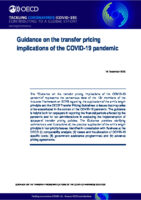
OECD Guidance on the transfer pricing implications of the COVID-19 pandemic
Unique economic conditions arising from COVID-19 and government responses to the pandemic have led to practical challenges for the application of the arm’s length principle. For taxpayers applying transfer pricing rules for the financial years impacted by the COVID-19 pandemic and for tax administrations that will be evaluating this application, there is an urgent need to address these practical questions. The OECD Transfer Pricing Guidelines for Multinational Enterprises and Tax Administrations 2017 (“OECD TPG”) are intended to help tax administrations and multinational enterprises (“MNEs”) find mutually satisfactory solutions to transfer pricing cases and should continue to be relied upon when performing a transfer pricing analysis, including under the possibly unique circumstances introduced by the pandemic. Accordingly, guidance have been issued focusing on how the arm’s length principle and the OECD TPG apply to issues that may arise or be exacerbated in the context of the COVID-19 pandemic, rather than on developing specialised guidance beyond what is currently addressed in the OECD TPG. Follow this link to see the COVID-19 guidance with relevant keywords and TPG references. The guidance focuses on four priority issues: (i) comparability analysis; (ii) losses and the allocation of COVID-19 specific costs; (iii) government assistance programmes; and (iv) advance pricing agreements (“APAs”); where it is recognised that the additional practical challenges posed by COVID-19 are most significant.
Diageo – British multinational beverage and alcohol group – is facing various tax challenges
Diageo (British multinational beverage and alcohol group – owner of numerus brands including Jonny Walker, Captain Morgan, Gordons Gin, Smirnoff and Guinness) is facing difficult tax challenges according to the group’s August 2020 SEC-filings During 2017 Diageo was in discussions with UK tax authorities to seek clarity on Diageo’s transfer pricing and related issues, and in the first half of the year ending 30 June 2018 a preliminary assessment for diverted profits tax notice was issued. Final charging notices were issued in August 2017 and Diageo paid £107 million in respect of the two years ended 30 June 2016. In June 2018 an agreement was reached with UK tax authorities that diverted profits tax does not apply the Diageo and at the same time a resolution was reached on the transfer pricing issues being discussed. The agreement in respect of transfer pricing covers the period from 1 July 2014 to 30 June 2017 and has resulted in an additional UK tax charge of £143 million. In the year ended 30 June 2018 an additional tax charge of £47 million was recognised in current tax which is based on the approach agreed with UK tax authorities. In April 2019, the European Commission issued its decision in a state aid investigation into the Group Financing Exemption in the UK controlled foreign company rules. The European Commission found that part of the Group Financing Exemption constitutes state aid. The Group Financing Exemption was introduced in legislation by the UK government in 2013. In common with other UK-based international companies whose arrangements are in line with current UK CFC legislation Diageo may be affected by the ultimate outcome of this investigation. The UK government and other UK-based international companies, including Diageo, have appealed to the General Court of the European Union against the decision. The UK government is required to commence collection proceedings and therefore it is expected that Diageo will have to make a payment in the year ending 30 June 2021 in respect of this case. At present it is not possible to determine the amount that the UK government will seek to collect. If the decision of the European Commission is upheld, Diageo calculates its maximum potential liability to be approximately £275 million. Based on its current assessment, Diageo believes that no provision is required in respect of this issue. In July 2019 Diageo reached a resolution with the French tax authorities on the treatment of interest costs for all open periods which resulted in a total exceptional charge of €100 million (£88 million), comprising a tax charge of €69 million (£61 million), penalties of €21 million (£18 million) and interest of €10 million (£9 million). This brought to a close all open issues with the French tax authorities for periods up to and including 30 June 2017. Diageo also has a large number of ongoing tax cases in Brazil and India. The current assessment of the aggregate possible exposures is up to approximately £285 million for Brazil and up to approximately £150 million for India. The group believes that the likelihood that the tax authorities will ultimately prevail is lower than probable but higher than remote. Due to the fiscal environment in Brazil and in India the possibility of further tax assessments related to the same matters cannot be ruled out. Based on its current assessment, Diageo believes that no provision is required in respect of these issues. Diageo states that payments were made under protest in India in respect of the periods 1 April 2006 to 31 March 2017 in relation to tax assessments where the risk is considered to be remote or possible. These payments have to be made in order to challenge the assessments and as such have been recognised as a receivable on the consolidated balance sheet. The total amount of protest payments recognised as a receivable as at 30 June 2020 is £117 million (corporate tax payments of £107 million and indirect tax payments of £10 million).
Airbnb under examination by the Internal Revenue Service for 2013 and 2016
Airbnb is under examination by the Internal Revenue Service for its income taxes in 2013 and 2016, according to the company’s December 2020 SEC filing. According to the filing a draft notice of adjustment from the IRS proposes that the company owes an additional $1.35 billion in taxes plus interest and penalties for the years in question. The assessment is related to valuation of its intellectual property that was transferred to a subsidiary in FY 2013. Airbnb then had had two subsidiaries outside the United States – Airbnb International Holdings Ltd and Airbnb International Unlimited Co – both resident for tax purposes in tax haven Jersey. The company plans to fight a potential adjustment. “We disagree with the proposed adjustment and intend to vigorously contest it,” “If the IRS prevails in the assessment of additional tax due based on its position and such tax and related interest and penalties, if any, exceeds our current reserves, such outcome could have a material adverse impact on our financial position and results of operations, and any assessment of additional tax could require a significant cash payment and have a material adverse impact on our cash flow,” Finally, it appears that the company is now in the process of moving its intellectual property back to the United States. Excerpts From Airbnb’s SEC filings “We are currently under examination for income taxes by the Internal Revenue Service (“IRS”) for the years 2013 and 2016. We are continuing to respond to inquiries related to these examinations. While we have not yet received a Revenue Agent’s Report generally issued at the conclusion of an IRS examination, in September 2020, we received a Draft Notice of Proposed Adjustment from the IRS for the 2013 tax year relating to the valuation of our international intellectual property which was sold to a subsidiary in 2013. The notice proposes an increase to our U.S. taxable income that could result in additional income tax expense and cash tax liability of $1.35 billion, plus penalties and interest, which exceeds our current reserve recorded in our consolidated financial statements by more than $1.0 billion. A formal Notice of Proposed Adjustment is expected from the IRS by the end of 2020. Following formal receipt of the Revenue Agent’s adjustment which is anticipated late in the fourth quarter of 2020, we intend to vigorously contest the IRS’s proposed adjustment, including through all administrative and, if necessary, judicial remedies which may include: entering into administrative settlement discussions with the IRS Independent Office of Appeals (“IRS Appeals”) in 2021, and if necessary petitioning the U.S. Tax Court (“Tax Court”) for redetermination if an acceptable outcome cannot be reached with IRS Appeals, and finally, and if necessary, appealing the Tax Court’s decision to the appropriate appellate court. If the IRS prevails in the assessment of additional tax due based on its position and such tax and related interest and penalties, if any, exceeds our current reserves, such outcome could have a material adverse impact on our financial position and results of operations, and any assessment of additional tax could require a significant cash payment and have a material adverse impact on our cash flow.“ “We may have exposure to greater than anticipated income tax liabilities. In September 2020, we received a Draft Notice of Proposed Adjustment from the IRS for the 2013 tax year proposing an increase to our U.S. taxable income that could result in additional income tax expense and cash tax liability of $1.35 billion, plus penalties and interest, which exceeds our current reserve recorded in our consolidated financial statements by more than $1.0 billion.“ “The Company is in various stages of examination in connection with its ongoing tax audits globally, and it is difficult to determine when these examinations will be settled. The Company believes that an adequate provision has been recorded for any adjustments that may result from tax audits. However, the outcome of tax audits cannot be predicted with certainty. If any issues addressed in the Company’s tax audits are resolved in a manner not consistent with management’s expectations, the Company may be required to record an adjustment to the provision for income taxes in the period such resolution occurs. It is reasonably possible that over the next 12-month period the Company may experience an increase or decrease in its unrecognized tax benefits as a result of tax examinations or lapses of the statute of limitations. However, an estimate of the range of the reasonably possible change in the next twelve months cannot be made.“ “On July 27, 2015, the United States Tax Court (the “Tax Court”) issued an opinion in Altera Corp. v. Commissioner (the “Tax Court Opinion”), which concluded that related parties in a cost sharing arrangement are not required to share expenses related to stock-based compensation. The Tax Court Opinion was appealed by the Commissioner to the Ninth Circuit Court of Appeals (the “Ninth Circuit”). On June 7, 2019, the Ninth Circuit issued an opinion (the “Ninth Circuit Opinion”) that reversed the Tax Court Opinion. On July 22, 2019, Altera Corp. filed a petition for a rehearing before the full Ninth Circuit. On November 12, 2019, the Ninth Circuit denied Altera Corp.’s petition for rehearing its case. The Company accordingly recognized tax expense of $26.6 million related to changes in uncertain tax positions during the year ended December 31, 2019. The Company will continue to monitor future developments in this case to determine if there will be further impacts to its consolidated financial statements.” “The Ninth Circuit Court of Appeals issued a decision in Altera Corp. v. Commissioner in June of 2019 regarding the treatment of stock-based compensation expense in a cost sharing arrangement, which had a material effect on our tax obligations and effective tax rate for the quarter in which the decision was issued.” “The Company is in the process of providing documentation to the Internal Revenue Service in connection with an examination of the Company’s 2013 income taxes with the primary issue under examination being the valuation of the

Poland issues Tax clarifications on transfer pricing – No. 2: Transfer Pricing Adjustments
31 March 2021 the Polish Ministry of Finance issued tax clarifications on transfer pricing – No. 2: Transfer Pricing Adjustments Click here for unofficial English translation

Poland issues Tax clarifications on transfer pricing – No. 3: CUP method
31 March 2021 the Polish Ministry of Finance published tax explanations on transfer pricing No. 3 regarding the CUP method The explanations covers: the rationale for using the comparable uncontrolled price method, variants of the comparable uncontrolled price method, comparison of the comparable uncontrolled price method with other methods, typical areas of application of the comparable uncontrolled price method, difficulties in applying the comparable uncontrolled price method, example of using the comparable uncontrolled price method. Click here for unofficial English translation
EU: Public Country-by-Country Reporting?
Proposal directive of public country-by-country reporting in the EU Ministers held an exchange of views (public session) on how to take the proposed directive forward. Tax transparency is a fundamental principle in any democratic society. It enables policy makers to take informed decisions and to ensure that all economic actors contribute in a fair and equitable manner to the economy of the various countries where they conduct their business. Today’s debate has opened the way for the proposed directive to move forward as a matter of priority. Pedro Siza Vieira, Portuguese Minister of State for the Economy and Digital Transition A clear majority of ministers were of the view that the latest consolidated presidency proposal is technically mature. They invited the Portuguese presidency to seek a negotiating mandate without delay in order to explore with the European Parliament the possibility of a deal for the swift adoption of the directive. The Portuguese presidency concluded that there was political support for it to seek a negotiating mandate in order to explore with the European Parliament the possibility of a deal for the swift adoption of the proposed directive. (Source: European Council)
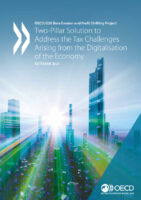
OECD deal on taxation of MNEs – Global Minimum Tax of 15%
Major reform of the international tax system finalised today at the OECD will ensure that Multinational Enterprises (MNEs) will be subject to a minimum 15% tax rate from 2023. The landmark deal, agreed by 136 countries and jurisdictions representing more than 90% of global GDP, will also reallocate more than USD 125 billion of profits from around 100 of the world’s largest and most profitable MNEs to countries worldwide, ensuring that these firms pay a fair share of tax wherever they operate and generate profits. Following years of intensive negotiations to bring the international tax system into the 21st century, 136 jurisdictions (out of the 140 members of the OECD/G20 Inclusive Framework on BEPS) joined the Statement on the Two-Pillar Solution to Address the Tax Challenges Arising from the Digitalisation of the Economy. It updates and finalises a July political agreement by members of the Inclusive Framework to fundamentally reform international tax rules. With Estonia, Hungary and Ireland having joined the agreement, it is now supported by all OECD and G20 countries. Four countries – Kenya, Nigeria, Pakistan and Sri Lanka – have not yet joined the agreement. The two-pillar solution will be delivered to the G20 Finance Ministers meeting in Washington D.C. on 13 October, then to the G20 Leaders Summit in Rome at the end of the month. The global minimum tax agreement does not seek to eliminate tax competition, but puts multilaterally agreed limitations on it, and will see countries collect around USD 150 billion in new revenues annually. Pillar One will ensure a fairer distribution of profits and taxing rights among countries with respect to the largest and most profitable multinational enterprises. It will re-allocate some taxing rights over MNEs from their home countries to the markets where they have business activities and earn profits, regardless of whether firms have a physical presence there. Specifically, multinational enterprises with global sales above EUR 20 billion and profitability above 10% – that can be considered as the winners of globalisation – will be covered by the new rules, with 25% of profit above the 10% threshold to be reallocated to market jurisdictions. Under Pillar One, taxing rights on more than USD 125 billion of profit are expected to be reallocated to market jurisdictions each year. Developing country revenue gains are expected to be greater than those in more advanced economies, as a proportion of existing revenues. Pillar Two introduces a global minimum corporate tax rate set at 15%. The new minimum tax rate will apply to companies with revenue above EUR 750 million and is estimated to generate around USD 150 billion in additional global tax revenues annually. Further benefits will also arise from the stabilisation of the international tax system and the increased tax certainty for taxpayers and tax administrations. “Today’s agreement will make our international tax arrangements fairer and work better,” said OECD Secretary-General Mathias Cormann. “This is a major victory for effective and balanced multilateralism. It is a far-reaching agreement which ensures our international tax system is fit for purpose in a digitalised and globalised world economy. We must now work swiftly and diligently to ensure the effective implementation of this major reform,” Secretary-General Cormann said. Countries are aiming to sign a multilateral convention during 2022, with effective implementation in 2023. The convention is already under development and will be the vehicle for implementation of the newly agreed taxing right under Pillar One, as well as for the standstill and removal provisions in relation to all existing Digital Service Taxes and other similar relevant unilateral measures. This will bring more certainty and help ease trade tensions. The OECD will develop model rules for bringing Pillar Two into domestic legislation during 2022, to be effective in 2023. Developing countries, as members of the Inclusive Framework on an equal footing, have played an active role in the negotiations and the Two-Pillar Solution contains a number of features to ensure that the concerns of low-capacity countries are addressed. The OECD will ensure the rules can be effectively and efficiently administered, also offering comprehensive capacity building support to countries which need it.
UN agrees on inclusion of Article 12B to the UN Model Tax Treaty – computer software
On 26. April 2021 the UN released agreed changes to the commentary on Article 12 of the United Nations Model Double Taxation Convention reflecting decisions made with respect to the inclusion of Article 12B and the treatment of computer software.
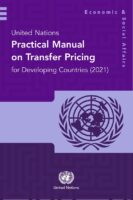
UN releases New 2021 Practical Manual on Transfer Pricing
On 27 April UN released a new 2021 Practical Manual on Transfer Pricing. “…this third edition of the Manual makes improvements in usability and practical relevance, updates and improves the existing text, including on Country Practices (Part D) and has new content, in particular, on financial transactions, profit splits, centralized procurement functions and comparability issues. Improved capacity development based on the Manual has encouraged and contextualized developing country feedback, helped identify these priority areas for improvement and contributed to better targeting the messages in the Manual and examples used.” The changes in the new edition of the Manual include: • A revised format and a rearrangement of some parts of the Manual for clarity and ease of understanding, including a reorganization into four parts as follows: – Part A relates to transfer pricing in a global environment; – Part B contains guidance on design principles and policy considerations; this Part covers the substantive guidance on the arm’s length principle, with Chapter B.1. providing an overview, while Chapters B.2. to B.7. provide detailed discussion on the key topics. Chapter B.8. then demonstrates how some countries have established a legal framework to apply these principles; – Part C addresses practical implementation of a transfer pricing regime in developing countries; and – Part D contains country practices, similarly to Chapter 10 of the previous edition of the Manual. A new statement of Mexican country practices is included and other statements are updated; • A new chapter on intra-group services; • A new chapter on cost contribution arrangements; • A new chapter on the treatment of intangibles; • Significant updating of other chapters; and • An index to make the contents more easily accessible.
Paraguay’s TP Decree in effect as of April 2021
Paraguay’s new Transfer Pricing Decree in effect as of April 2021. Click here for English Translation

Australia finalises compliance guideline on intangibles migration arrangements – PCG 2024/1
17 January 2024 the Australian Taxation Office published the final version of its Practical Compliance Guideline PCG 2024/1 Intangibles migration arrangements. The PCG has previously been released in drafts as PCG 2021/D4 and PCG 2023/D2 Intangibles arrangements. The final version sets out ATO’s compliance approach to the tax risks associated with certain cross-border related party intangibles arrangements involving: restructures or changes to arrangements involving intangible assets (referred to as ‘migrations’ in the PCG) the mischaracterisation or non-recognition of Australian activities connected with intangible assets. Changes and additions included in the final version: further clarification of the arrangements in scope exclusion of certain arrangements (‘Excluded Intangibles Arrangement’) from the scope inclusion of a ‘white zone’ for arrangements that have been subject to previous ATO audit or reviews further explaining our compliance approach, including the engagement taxpayers can expect based on the compliance risks associated with an arrangement expanding the guidance allowing taxpayers to group intangible assets or arrangements to make it easier for taxpayers apply the PCG providing more information on the reporting requirements taxpayers can expect to complete the reportable tax position schedule.

2023: ATO Draft Practical Compliance Guidelines on Intangibles Arrangements, PCG 2023/D2
The Australian Taxation Office (ATO) has released a new draft of Compliance Guidelines on Intangible Arrangements, PCG 2023/D2. When finalised, the guidelines will set out the ATO’s compliance approach to the development, use and transfer of intangible assets. The guidelines focus on tax risks associated with the potential application of the transfer pricing provisions, withholding tax provisions, capital gains tax (CGT), capital allowances, the general anti-avoidance rule (GAAR) and the diverted profits tax (DPT). Examples of high-risk intangibles arrangements under the draft guidelines include centralisation of intangible assets bifurcation (separation) of intangible assets non-recognition of local intangible assets and DEMPE activities migration of pre-commercialised intangible assets (HTVI) transfer of intangibles assets to a foreign hybrid entity

2021: ATO Draft Practical Compliance Guidelines on Intangibles Arrangements, PCG 2021/D4
The Australian Taxation Office (ATO) has issued draft Compliance Guidelines on intangible arrangements, PCG 2021/D4. These Guidelines will (when finalised) set out the ATO’s compliance approach to international arrangements connected with the development, enhancement, maintenance, protection and exploitation of intangible assets, specifically, the potential application of the transfer pricing, general anti-avoidance rule (GAAR) and the diverted profits tax (DPT) provisions. The capital gains tax and capital allowances provisions will also be discussed in this Guideline where these may be considered alongside, or relevant to, the ATO’s transfer pricing, GAAR or DPT risk assessment. The draft Guidelines sets out ATO’s compliance approach to international arrangements connected with the development, enhancement, maintenance, protection and exploitation (DEMPE) of intangible assets and/or involving a migration of intangible assets. The Guidelines applies to Intangibles Arrangements and focuses on tax risks associated with the potential application of the transfer pricing provisions. It also focuses on other tax risks that may be associated with Intangibles Arrangements, specifically the withholding tax provisions, capital gains tax (CGT), capital allowances, the general anti-avoidance rule (GAAR) and the diverted profits tax (DPT). The Guidelines has been prepared to accompany the release and publication of Taxpayer Alerts TA 2018/2 Mischaracterisation of activities or payments in connection with intangible assets and TA 2020/1 Non-arm’s length arrangements and schemes connected with the development, enhancement, maintenance, protection and exploitation of intangible assets. It is not the intention of the Guidelines to limit, deter or prevent arm’s length dealings involving intangible assets. Rather it is intended that the Guideline will serve as a point of reference and assist in understanding arrangements which is seen as representing a higher risk from a compliance perspective. Examples of high risk arrangements centralisation of intangible assets bifurcation (separation) of intangible assets non-recognition of local intangible assets and DEMPE activities migration of pre-commercialised intangible assets non-arm’s length licence arrangements

OECD: Fighting Tax Crime – The Ten Global Principles, Second Edition
“Fighting Tax Crime – The Ten Global Principles” is a comprehensive guide to fighting tax crimes published by the OECD. Read the online report here. The report sets out ten essential principles covering the legal, institutional, administrative, and operational aspects necessary for developing an efficient and effective system for identifying, investigating and prosecuting tax crimes, while respecting the rights of accused taxpayers. The guidance also addresses new challenges, such as tackling professionals who enable tax and white-collar crimes, and fostering international co-operation in the recovery of assets. Drawing on the experiences of jurisdictions in all continents, the report also highlights successful cases relating to the misuse of virtual assets, complex investigations involving joint task forces, and the use of new technology tools to fight tax crimes and other financial crimes. The ten principles are 1Ensure tax offences are criminalisedJurisdictions should have the legal framework in place to ensure that violations of tax law are included as a criminal offence, and that effective sanctions apply in practice. 2Devise an effective strategy for addressing tax crimesIn order to ensure the effectiveness of the law on tax crimes, jurisdictions should have a strategy for addressing tax crimes. The strategy should be regularly reviewed and monitored. 3Have adequate investigative powersJurisdictions must have appropriate investigative powers to successfully investigate tax crimes. 4Have effective powers to freeze, seize and confiscate assetsJurisdictions should have the ability to freeze / seize assets in the course of a tax crime investigation, and the ability to confiscate assets. 5Put in place an organisational structure with defined responsibilitiesA Jurisdiction should have an organisational model with defined responsibilities for fighting tax crime and other financial crime. 6Provide adequate resources for tax crime investigationTax crime investigation agencies should have adequate resources. 7Make tax crimes a predicate offence for money launderingJurisdictions should designate tax crimes as one of the predicate offences for money laundering. 8Have an effective framework for domestic inter-agency co-operationJurisdictions should have an effective legal and administrative framework to facilitate collaboration between tax authorities and other domestic law enforcement and intelligence agencies. 9Ensure international co-operation mechanisms are availableTax crime investigation agencies must have access to criminal legal instruments and an adequate operational framework for effective international co-operation in the investigation and prosecution of tax crimes. 10Protect suspects’ rightsTaxpayers suspected or accused of committing a tax crime must be able to rely on basic procedural and fundamental rights. Alongside the policy document, the report has 33 country chapters, detailing jurisdictions’ domestic tax crime enforcement frameworks as well as the progress made in implementing the Ten Global Principles. These country chapters of the repost are available here.

German TP-Legislation updated as of June 2021
German legislation on transfer pricing has been updated to align the rules with the OECD Transfer Pricing Guidelines 2017. The new amendments are effective as of fiscal year 2022. The rules includes revised content on Substance over form Risk analysis Best method rule Use of interquartile range Aggregation of transactions Determination of actual ownership vs legal ownership DEMPE functions Valuation of Hard to value intangibles Unofficial translation of the new amendments to the German TP legislation Article 5 Amendment of the Foreign Tax Act The Foreign Tax Act of 8 September 1972 (BGBl. I p. 1713), as last amended by Article 4 of the Act of 25 March 2019 (BGBl. I p. 357), shall be amended as follows: section 1 shall be amended as follows: (a) Paragraph 1 shall be amended as follows: aa) In sentence 1, the words “related” shall be replaced by the word “related”. bb) In sentence 2, the words “and within the meaning of § 1a” shall be inserted after the word “provision”. (b) Paragraph 3 shall be replaced by the following paragraphs 3 to 3c: “(3) For the determination of the transfer prices (arm’s length prices) corresponding to the arm’s length principle for a business relationship within the meaning of paragraph 1 sentence 1, the actual circumstances underlying the respective business transaction shall be decisive. In particular, it shall be taken into account which functions are performed by which person involved in the business transaction in relation to the respective business transaction, which risks are assumed in this respect and which assets are used for this purpose (function and risk analysis). The relationships within the meaning of sentences 1 and 2 shall form the standard for determining the comparability of the business transaction to be examined with business transactions between unrelated third parties (comparability analysis); the relationships on which these business transactions are based shall be decisive in the corresponding application of sentences 1 and 2, insofar as this is possible. The circumstances at the time of the agreement of the business transaction shall be taken into account. The arm’s length price shall in principle be determined according to the most appropriate transfer pricing method with regard to the comparability analysis and the availability of values for comparable transactions of independent third parties. Differences between the ratios of the arm’s length transactions used for comparison and the ratios underlying the transaction under review that may affect the application of the transfer pricing method shall be eliminated by appropriate adjustments, if possible; this shall only apply if comparability is thereby enhanced. If no comparative values can be determined, a hypothetical arm’s length comparison shall be carried out for the determination of the arm’s length price in compliance with paragraph 1 sentence 3 from the perspective of the supplier and the respective service recipient using economically recognised valuation methods. (3a) The application of the arm’s length principle regularly leads to a range of values. This range shall be narrowed if differences in comparability remain after application of paragraph 3 sentence 6. If these values themselves do not offer any indications for a certain narrowing, the quarter of the smallest and the quarter of the largest values shall be disregarded from this range. If the value used by the taxpayer to determine his income lies outside the range pursuant to sentence 1 or the narrowed range, the median shall be decisive if the taxpayer does not credibly demonstrate that another value complies with the arm’s length principle. When applying the hypothetical arm’s length principle according to paragraph 3, sentence 7, a range of agreement regularly results from the minimum price of the supplier and the maximum price of the service recipient. In the cases of sentence 5, the mean value of the agreement range shall be used as a basis if the taxable person does not credibly demonstrate that another value within the agreement range complies with the arm’s length principle. (3b) If a function, including the associated opportunities and risks as well as the assets or other benefits transferred along with the function, is transferred and paragraph 3 sentence 7 is to be applied to the transferred function because no comparative data can be determined for the transfer of the function as a whole (transfer package), the agreement range shall be determined on the basis of the transfer package. This may be waived if the taxpayer can credibly demonstrate that neither significant intangible assets nor other benefits were the subject of the transfer of function. This applies if the receiving company performs the transferred function exclusively vis-à-vis the transferring company and the consideration to be recognised for the performance of the function and the provision of the corresponding services is to be determined according to the cost-plus method. (3c. A transfer or assignment for use of an intangible asset shall be remunerated if it is made on the basis of a business relationship as defined in paragraph 4 and it has a financial effect on the transferee, the user, the transferor or the assignor. Intangible assets are assets that are neither tangible assets nor equity interests nor financial assets which may be the subject of a transaction without being individually transferable; and which can give a person an actual or legal position over that asset. The identification of the ownership or holder of an intangible asset, including rights derived from such an asset, is the starting point for determining which party to the transaction is entitled to the revenue arising from any disposition of that intangible asset. To the extent that a related party of the owner or holder of the intangible asset performs functions, uses assets or assumes risks in connection with the development or creation, enhancement, maintenance, protection or any form of exploitation of the intangible asset, those functions shall be appropriately compensated by the owner or holder of the related party. The financing of the development or creation, maintenance or protection of an intangible asset shall be appropriately remunerated and shall not give rise

Pandora Papers – a new leak of financial records
A new huge leak of financial records revealed by ICIJ, once again shows widespread use of offshore accounts, shell companies and trusts to hide wealth and/or avoid taxes. The new leak is known as the Pandora Papers and follows other recent leaks – lux leak, panama papers, paradise papers. The International Consortium of Investigative Journalists obtained 11.9 million confidential documents from 14 separate legal and financial services firms, which the group said offered “a sweeping look at an industry that helps the world’s ultrawealthy, powerful government officials and other elites conceal trillions of dollars from tax authorities, prosecutors and others.” “The key players in the system include elite institutions – multinational banks, law firms and accounting practices – headquartered in the U.S. and Europe.” The Consortium said the 2.94 terabytes of financial and legal data shows the “offshore money machine operates in every corner of the planet, including the world’s largest democracies,” and involves some of the world’s most well-known banks and legal firms. “The Pandora Papers provide more than twice as much information about the ownership of offshore companies. In all, the new leak of documents reveals the real owners of more than 29,000 offshore companies. The owners come from more than 200 countries and territories, with the largest contingents from Russia, the U.K., Argentina and China.”

ATO and Singtel in Court over Intra-company Financing Arrangement
In 2001, Singtel, through its wholly owned Australian subsidiary, Singapore Telecom Australia Investments Pty Limited (Singtel Au), acquired the majority of the shares in Cable & Wireless Optus for $17.2 billion. The tax consequences of this acqusition was decided by the Federal Court in Cable & Wireless Australia & Pacific Holding BV (in liquiatie) v Commissioner of Taxation [2017] FCAFC 71. Cable & Wireless argued that part of the price paid under a share buy-back was not dividends and that withholding tax should therefor be refunded. The ATO and the Court disagreed. ATO and Singtel is now in a new dispute – this time over tax consequences associated with the intra-group financing of the takeover. This case was heard in the Federal Court in August 2021. At issue is a tax assessments for FY 2011, 2012 and 2013 resulting in additional taxes in an amount $268 million. In the assessment interest deductions claimed in Australia on notes issued under a Loan Note Issuance Agreement (LNIA) has been disallowed by the ATO.
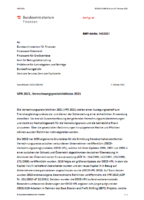
Austrian Ministry of Finance issues Updated Local Transfer Pricing Guidelines (VPR 2021)
In October 2021 the Austrian Ministry of Finance issues updated local transfer pricing guidelines – VPR 2021 The Transfer Pricing Guidelines 2021 (VPR 2021) are an interpretative aid to the arm’s length principle and serve to ensure its uniform application. They are to be regarded as a summary of the applicable transfer pricing provisions and thus as a reference work for administrative and operational practice. Rights and obligations that go beyond the statutory provisions cannot be derived from the guidelines. In 1995, the OECD published general principles for the determination of arm’s length transfer prices between associated enterprises (OECD Transfer Pricing Principles; OECD TPG), which were published with their updates in 1996, 1997 and 1998 in a German translation agreed between Switzerland and Austria in the Official Gazette of the Austrian Tax Administration (AÖF No. 114/1996, 122/1997, 155/1998, 171/2000). In 2010, a major update of the OECD TPG followed, in which Chapters I to III were revised in depth and a new Chapter IX relating to corporate reorganisations was added (OECD TPG 2010). Based on this, Austria’s own guidelines were published for the first time in 2010: the VPR 2010 (AÖF No. 221/2010 idF 22/2011). Since then, the OECD TPG have been continuously developed. Particularly comprehensive changes to the OECD TPG have recently resulted from the OECD/G20 work in the context of the Base Erosion and Profit Shifting (BEPS) project which VPR 2021 GZ 2021-0.586.616 of 07 October 2021 resulted in an update in 2017 (OECD-TPG 2017). Therefore, there is a need for a fundamental revision of the VPR 2010, a repeal of the existing enactments and a new promulgation of the VPR (VPR 2021). Within the scope of this fundamental revision, the previous structure of the VPR was largely retained, but some very comprehensive additions were necessary. In addition, the latest version of the BMF Info on the Transfer Pricing Documentation Act (BMF Info of 17 December 2019, BMF-010221/0395-IV/8/2019) was incorporated into the VPR as section 3.2. For reasons of clarity and transparency, the VPR are therefore newly promulgated. The VPR 2021 replace the Transfer Pricing Guidelines 2010 (VPR 2010). Link to Austrian Local Transfer Pricing Guidelines 2021 Unofficial English Translation

Poland issues tax clarifications on transfer pricing – No. 4: Transactional Net Margin Method (TNMM)
1 December 2021 the Polish Ministry of Finance issued Tax clarifications on transfer pricing No. 4: Transactional Net Margin Method (TNMM) Clarification on application of the TNMM is provided in these areas: A. Principles of TNMM use A.1. Scope of application of the method A.2. Tested party A.3. Determination of net profit margin A.4. Definition of the base A.5. Choice of profitability indicator A.6. Profitability comparison B. Criteria for comparability of transactions and entities C. Difficulties in applying TNMM D. Comparison with other methods E. Practical application of TNMM Click here for unofficial English translation

Amgen in $3.6 billion transfer pricing dispute with the IRS
Amgen, in a note to its financial statement for the quarterly period ended June 30, 2021, disclosed that it has been issued tax assessments of approximately $3.6b plus interest for tax years 2010, 2011 and 2012 by the IRS. Proposed adjustments for FY 2013, 2014 and 2015 has also been issued. The dispute relates to the allocation of profits between Amgen group entities in the United States and the U.S. territory of Puerto Rico. According to the note, Amgen has filed a petition in the U.S. Tax Court to contest the assessments. 4. Income taxes The effective tax rates for the three and six months ended June 30, 2021, were 16.8% and 12.6%, respectively, compared with 11.2% and 10.4%, respectively, for the corresponding periods of the prior year. The increase in our effective tax rate for the three and six months ended June 30, 2021, was primarily due to the non-deductible IPR&D expense arising from the acquisition of Five Prime. The effective tax rates differ from the federal statutory rate primarily as a result of foreign earnings from the Company’s operations conducted in Puerto Rico, a territory of the United States that is treated as a foreign jurisdiction for U.S. tax purposes, that are subject to a tax incentive grant through 2035. In addition, the Company’s operations conducted in Singapore are subject to a tax incentive grant through 2034. These earnings are also subject to U.S. tax at a reduced rate of 10.5%. The U.S. territory of Puerto Rico imposes an excise tax on the gross intercompany purchase price of goods and services from our manufacturer in Puerto Rico. The rate of 4% is effective through December 31, 2027. We account for the excise tax as a manufacturing cost that is capitalized in inventory and expensed in cost of sales when the related products are sold. For U.S. income tax purposes, the excise tax results in foreign tax credits that are generally recognized in our provision for income taxes when the excise tax is incurred. One or more of our legal entities file income tax returns in the U.S. federal jurisdiction, various U.S. state jurisdictions and certain foreign jurisdictions. Our income tax returns are routinely examined by tax authorities in those jurisdictions. Significant disputes may arise with tax authorities involving issues regarding the timing and amount of deductions, the use of tax credits and allocations of income and expenses among various tax jurisdictions because of differing interpretations of tax laws, regulations and relevant facts. In 2017, we received a Revenue Agent Report (RAR) and a modified RAR from the Internal Revenue Service (IRS) for the years 2010, 2011 and 2012 proposing significant adjustments that primarily relate to the allocation of profits between certain of our entities in the United States and the U.S. territory of Puerto Rico. We disagreed with the proposed adjustments and calculations and pursued a resolution with the IRS administrative appeals office. As previously reported, we were unable to reach resolution with the IRS appeals office. In July 2021, we filed a petition in the U.S. Tax Court to contest two duplicate Statutory Notices of Deficiency (Notices) for 2010, 2011 and 2012 that we received in May and July 2021. The duplicate Notices seek to increase our U.S. taxable income by an amount that would result in additional federal tax of approximately $3.6 billion, plus interest. Any additional tax that could be imposed would be reduced by up to approximately $900 million of repatriation tax previously accrued on our foreign earnings. In any event, we firmly believe that the IRS’s positions in the Notices are without merit and we will vigorously contest the Notices through the judicial process. In addition, in 2020, we received an RAR and a modified RAR from the IRS for the years 2013, 2014 and 2015 also proposing significant adjustments that primarily relate to the allocation of profits between certain of our entities in the United States and the U.S. territory of Puerto Rico, similar to those proposed for the years 2010, 2011 and 2012. We disagree with the proposed adjustments and calculations and are pursuing resolution with the IRS administrative appeals office. We are currently under examination by the IRS for the years 2016, 2017 and 2018. We are also currently under examination by a number of other state and foreign tax jurisdictions. Final resolution of these complex matters is not likely within the next 12 months. We believe our accrual for income tax liabilities is appropriate based on past experience, interpretations of tax law, application of the tax law to our facts and judgments about potential actions by tax authorities; however, due to the complexity of the provision for income taxes and uncertain resolution of these matters, the ultimate outcome of any tax matters may result in payments substantially greater than amounts accrued and could have a material adverse impact on our condensed consolidated financial statements. We are no longer subject to U.S. federal income tax examinations for the years ended on or before December 31, 2009. During the three and six months ended June 30, 2021, the gross amounts of our unrecognized tax benefits (UTBs) increased $50 million and $110 million, respectively, as a result of tax positions taken during the current year. Substantially all of the UTBs as of June 30, 2021, if recognized, would affect our effective tax rate.

ResMed Inc has entered a $381.7 million tax settlement agreement with the Australian Tax Office
ResMed – a world-leading digital health company – in an October 2021 publication of results for the first quarter of FY 2022, informs that a $381.7 million tax settlement agreement has been entered with the Australian Tax Office. The dispute concerns the years 2009 through 2018, in which the ATO alleged that ResMed should have paid additional Australian taxes on income derived from the company’s Singapore operations. Excerpts from the announcement “Operating cash flow for the quarter was negative $65.7 million and was impacted by a payment to the Australian Tax Office of $284.8 million, which was the settlement amount of $381.7 million net of prior remittances.” “During the quarter, concluded the settlement agreement with the Australian Taxation Office (“ATO”), which fully resolves the transfer pricing dispute for all prior years since 2009. ResMed previously recognized a tax reserve in êscal year 2021 in anticipation of the settlement. The net impact of the settlement was $238.7 million ($381.7 million gross less credits and deductions of $143.0 million). The settlement provides closure for historic Australian tax matters and greater clarity into the future. As a result of the ATO settlement and due to movements in foreign currencies, recognized a $4.1 million reduction in tax credits during the quarter, which was recorded as an increase in income tax expense.“ Back in 2015 ResMed rigorously defended its tax position in a submission to the Australien Senate Economics Reference Committee following an inquiry into Corporate Tax Avoidance practices.

Pandora Papers – a new leak of financial records
A new huge leak of financial records revealed by ICIJ, once again shows widespread use of offshore accounts, shell companies and trusts to hide wealth and/or avoid taxes. The new leak is known as the Pandora Papers and follows other recent leaks – lux leak, panama papers, paradise papers. The International Consortium of Investigative Journalists obtained 11.9 million confidential documents from 14 separate legal and financial services firms, which the group said offered “a sweeping look at an industry that helps the world’s ultrawealthy, powerful government officials and other elites conceal trillions of dollars from tax authorities, prosecutors and others.” “The key players in the system include elite institutions – multinational banks, law firms and accounting practices – headquartered in the U.S. and Europe.” The Consortium said the 2.94 terabytes of financial and legal data shows the “offshore money machine operates in every corner of the planet, including the world’s largest democracies,” and involves some of the world’s most well-known banks and legal firms. “The Pandora Papers provide more than twice as much information about the ownership of offshore companies. In all, the new leak of documents reveals the real owners of more than 29,000 offshore companies. The owners come from more than 200 countries and territories, with the largest contingents from Russia, the U.K., Argentina and China.” “Pandora Papers” leaks: Statement by Bob Hamilton, Chair of the Forum on Tax Administration and Chris Jordan, Chair of the FTA’s Joint International Task Force on Shared Intelligence and Collaboration On October 14, a statement was issued by the OECD The Forum on Tax Administration and its Joint International Task Force on Shared Intelligence and Collaboration (JITSIC) are already working collaboratively in response to the recent “Pandora Papers” leaks. This follows the model successfully adopted for the Panama and Paradise Papers leaks. 14/10/2021 – The International Consortium of Investigative Journalists (ICIJ) has recently released information relating to its review of data leaks referred to as the Pandora Papers. As a result of the strong partnerships established through its JITSIC Network, the OECD Forum on Tax Administration (FTA) is well positioned to enable a collaborative approach to identifying and addressing aggressive tax avoidance and tax evasion involving multiple jurisdictions once the data becomes available. The FTA is dedicated to tax transparency and tax co-operation through the delivery of its collaborative work programme, and its members have access to a range of tools and platforms to help tackle offshore tax evasion and avoidance, including: The FTA’s JITSIC network, which provides an effective and well-established platform to its 42 members to cooperate directly on individual cases, as well as sharing their experience, resources and expertise. This direct and immediate collaboration proved to be very effective following the Panama and Paradise Papers leaks. JITSIC, like tax administrations more generally, operates under strict rules designed to protect the confidentiality of information and the confidence of taxpayers. As a consequence much of the work of JITSIC is not always visible to the public. The OECD standard on the exchange of information on request, which provides a powerful framework for tax administrations to receive detailed information on taxpayers’ offshore affairs from 163 jurisdictions. The OECD Common Reporting Standard (CRS) under which there is automatic reporting of information between more than 100 jurisdictions on the offshore financial accounts of non-residents, to their jurisdiction of residence. Information on these financial accounts, as well as the requirements envisaged by the transparency and exchange of information on request standard, ensure greater transparency of ownership of companies, trusts, and other similar structures, the importance of which has been illustrated in the Pandora Papers. As has been the case with previous leaks, JITSIC members will continue to work together to pool resources, share information and rapidly develop a more accurate picture of potential wrong doing in order to facilitate further investigations. While the information contained in such leaks can be of value in investigations, the inclusion of information about an individual or entity in a data leak does not automatically mean that there has been non-compliance.

Spain releases report on application of their General Anti-Abuse Rule.
The Spanish tax authorities have published a report on the applicability of their domestic General Anti-Abuse Rule (GAAR). In the report, a conduit arrangement aimed at benefiting from an exemption at source on the payment of interest to EU residents is described. Click here for English translation

OECD releases Pillar Two model rules – Global Minimum Tax of 15%
The OECD has published detailed rules to assist in the implementation of a landmark reform to the international tax system, which will ensure Multinational Enterprises (MNEs) will be subject to a minimum 15% tax rate from 2023. The Pillar Two model rules provide governments a precise template for taking forward the two-pillar solution to address the tax challenges arising from digitalisation and globalisation of the economy agreed in October 2021 by 137 countries and jurisdictions under the OECD/G20 Inclusive Framework on BEPS. The rules define the scope and set out the mechanism for the so-called Global Anti-Base Erosion (GloBE) rules under Pillar Two, which will introduce a global minimum corporate tax rate set at 15%. The minimum tax will apply to MNEs with revenue above EUR 750 million and is estimated to generate around USD 150 billion in additional global tax revenues annually. The GloBE rules provide for a co-ordinated system of taxation intended to ensure large MNE groups pay this minimum level of tax on income arising in each of the jurisdictions in which they operate. The rules create a “top-up tax” to be applied on profits in any jurisdiction whenever the effective tax rate, determined on a jurisdictional basis, is below the minimum 15% rate. The new Pillar Two model rules will assist countries to bring the GloBE rules into domestic legislation in 2022. They provide for a co-ordinated system of interlocking rules that: define the MNEs within the scope of the minimum tax; set out a mechanism for calculating an MNE’s effective tax rate on a jurisdictional basis, and for determining the amount of top-up tax payable under the rules; and impose the top-up tax on a member of the MNE group in accordance with an agreed rule order. The Pillar Two model rules also address the treatment of acquisitions and disposals of group members and include specific rules to deal with particular holding structures and tax neutrality regimes. Finally, the rules address administrative aspects, including information filing requirements, and provide for transitional rules for MNEs that become subject to the global minimum tax. In early 2022, the OECD will release the Commentary relating to the model rules and address co-existence with the US Global Intangible Low-Taxed Income (GILTI) rules. This will be followed by the development of an implementation framework focused on administrative, compliance and co-ordination issues relating to Pillar Two. The Inclusive Framework is also developing the model provision for a Subject to Tax Rule, together with a multilateral instrument for its implementation, to be released in the early part of 2022. A public consultation event on the implementation framework will be held in February and on the Subject to Tax Rule in March.
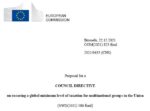
EU directive on minimum effective tax rate – implementation of OECD Pillar II
The European Commission has proposed a Directive ensuring a minimum effective tax rate for the global activities of large multinational groups. The proposal delivers on the EU’s pledge to move extremely swiftly and be among the first to implement the recent historic global tax reform agreement, which aims to bring fairness, transparency and stability to the international corporate tax framework. The proposed directive follows closely the international agreement and sets out how the principles of the 15% effective tax rate – agreed by 137 countries – will be applied in practice within the EU. It includes a common set of rules on how to calculate this effective tax rate, so that it is properly and consistently applied across the EU. The proposed rules will apply to any large group, both domestic and international, with a parent company or a subsidiary situated in an EU Member State. If the minimum effective rate is not imposed by the country where a low-taxed company is based, there are provisions for the Member State of the parent company to apply a “top-up” tax. The proposal also ensures effective taxation in situations where the parent company is situated outside the EU in a low-tax country which does not apply equivalent rules. In line with the global agreement, the proposal also provides for certain exceptions. To reduce the impact on groups carrying out real economic activities, companies will be able to exclude an amount of income equal to 5% of the value of tangible assets and 5% of payroll. The rules also provide for an exclusion of minimal amounts of profit, to reduce the compliance burden in low risk situations. This means that when the average profit and revenues of a multinational group in a jurisdiction are below certain minimum thresholds, then that income is not taken into account in the calculation of the rate. Background Minimum corporate taxation is one of the two work streams of the global agreement – the other is the partial re-allocation of taxing rights (known as Pillar 1). This will adapt the international rules on how the taxation of corporate profits of the largest and most profitable multinationals is shared amongst countries, to reflect the changing nature of business models and the ability of companies to do business without a physical presence. The Commission will also make a proposal on the reallocation of taxing rights in 2022, once the technical aspects of the multilateral convention are agreed.

December 2021 – EU directive on minimum effective tax rate – implementation of OECD Pillar II
The European Commission has proposed a Directive ensuring a minimum effective tax rate for the global activities of large multinational groups. The proposal delivers on the EU’s pledge to move extremely swiftly and be among the first to implement the recent historic global tax reform agreement, which aims to bring fairness, transparency and stability to the international corporate tax framework. The proposed directive follows closely the international agreement and sets out how the principles of the 15% effective tax rate – agreed by 137 countries – will be applied in practice within the EU. It includes a common set of rules on how to calculate this effective tax rate, so that it is properly and consistently applied across the EU. The proposed rules will apply to any large group, both domestic and international, with a parent company or a subsidiary situated in an EU Member State. If the minimum effective rate is not imposed by the country where a low-taxed company is based, there are provisions for the Member State of the parent company to apply a “top-up” tax. The proposal also ensures effective taxation in situations where the parent company is situated outside the EU in a low-tax country which does not apply equivalent rules. In line with the global agreement, the proposal also provides for certain exceptions. To reduce the impact on groups carrying out real economic activities, companies will be able to exclude an amount of income equal to 5% of the value of tangible assets and 5% of payroll. The rules also provide for an exclusion of minimal amounts of profit, to reduce the compliance burden in low risk situations. This means that when the average profit and revenues of a multinational group in a jurisdiction are below certain minimum thresholds, then that income is not taken into account in the calculation of the rate. Background Minimum corporate taxation is one of the two work streams of the global agreement – the other is the partial re-allocation of taxing rights (known as Pillar 1). This will adapt the international rules on how the taxation of corporate profits of the largest and most profitable multinationals is shared amongst countries, to reflect the changing nature of business models and the ability of companies to do business without a physical presence. The Commission will also make a proposal on the reallocation of taxing rights in 2022, once the technical aspects of the multilateral convention are agreed.
Finnish TP-Legislation updated to include non-recognition and recharacterisation
Effective as of 1. January 2022 Finnish Transfer Pricing legislation has been updated to align the rules with the OECD Transfer Pricing Guidelines in regards to non-recognition and recharacterisation. Going forward the arm’s length provision in the Tax Procedure Act, section 31, will include the possibility for non-recognition and recharacterisation which according to Finnish Case Law has not been possible under the previous wording of the provision.
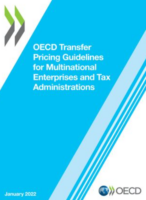
OECD releases the 2022 edition of the OECD Transfer Pricing Guidelines
On 20 January 2022 the OECD released the 2022 edition of the OECD Transfer Pricing Guidelines for Multinational Enterprises and Tax Administrations. The OECD Transfer Pricing Guidelines provide guidance on the application of the “arm’s length principle”, which represents the international consensus on the valuation, for income tax purposes, of cross-border transactions between associated enterprises. In today’s economy where multinational enterprises play an increasingly prominent role, transfer pricing continues to be high on the agenda of tax administrations and taxpayers alike. Governments need to ensure that the taxable profits of MNEs are not artificially shifted out of their jurisdiction and that the tax base reported by MNEs in their country reflects the economic activity undertaken therein and taxpayers need clear guidance on the proper application of the arm’s length principle. This latest edition consolidates into a single publication the changes to the 2017 edition of the Transfer Pricing Guidelines resulting from: The report Revised Guidance on the Transactional Profit Split Method, approved by the OECD/G20 Inclusive Framework on BEPS on 4 June 2018, and which replaced the guidance in Chapter II, Section C (paragraphs 2.114-2.151) found in the 2017 Transfer Pricing Guidelines and Annexes II and III to Chapter II; The report Guidance for Tax Administrations on the Application of the Approach to Hard-to-Value Intangibles, approved by the OECD/G20 Inclusive Framework on BEPS on 4 June 2018, which has been incorporated as Annex II to Chapter VI; The report Transfer Pricing Guidance on Financial Transactions, adopted by the OECD/G20 Inclusive Framework on BEPS on 20 January 2020, which has been incorporated into Chapter I (new Section D.1.2.2) and in a new Chapter X; The consistency changes to the rest of the OECD Transfer Pricing Guidelines needed to produce this consolidated version of the Transfer Pricing Guidelines, which were approved by the OECD/G20 Inclusive Framework on BEPS on 7 January 2022. The OECD guidance developed in regards of COVID 19 is not included in the new 2022 guidelines but is instead kept as a separate intermediate guidance. Buy an online pdf version or book version of the new 2022 Transfer Pricing Guidelines at https://oe.cd/tpg2022

South African Revenue Service releases comprehensive Interpretation Note on intra-group loans
The South African Revenue Service (SARS) has published a comprehensive Interpretation Note on intra-group loans. The note provides taxpayers with guidance on the application of the arm’s length principle in the context of the pricing of intra-group loans. The pricing of intra-group loans includes a consideration of both the amount of debt and the cost of the debt. An intra-group loan would be incorrectly priced if the amount of debt funding, the cost of the debt or both are excessive compared to what is arm’s length. The Note also provides guidance on the consequences for a taxpayer if the amount of debt, the cost of debt or both are not arm’s length. The guidance and examples provided are not an exhaustive consideration of every issue that might arise. Each case will be decided on its own merits taking into account its specific facts and circumstances. The application of the arm’s length principle is inherently of a detailed factual nature and takes into account a wide range of factors particular to the specific taxpayer concerned.

Italy releases operational instructions on arm’s length range and benchmarking.
On 24 May 2022, the Italian Tax Agency (Agenzia delle Entrate) released CIRCULAR NO. 16/E containing operational instructions on issues relating to application of the arm’s length range. The circular – which is based on the OECD transfer Pricing Guidelines, guidance on benchmark studies issued by the Joint Transfer Pricing Forum, and relevant Italian case laws – provides operational instructions regarding the correct interpretation of the notion of “arm’s length range”, as also specified in Article 6 of the Decree of 14 May 2018, when applying the provisions set forth in Article 110, paragraph 7, of the Consolidated Income Tax Act or of the provisions contained in the Double Taxation Treaties entered into by Italy in accordance with Article 9 of the OECD Model Convention. The operational instructions concludes as follows the correct application of the most appropriate transfer pricing method may, instead of a single value, lead to a range of values all complying with the arm’s length principle; in such cases, the full range of values within the arm’s length range may be used if all the transactions identified in the range are equally comparable; if, on the other hand, some of the transactions within the range show defects of comparability that cannot be reliably identified or quantified and, therefore adjusted, the use of ‘statistical tools’ (in order to strengthen their reliability) and a value within the narrow range is preferable. Recourse, on the other hand, to a value as central as possible within the range (also in order to minimise the risk of error due to the presence of such defects) must be limited to cases in which the range does not include values characterised by a sufficient degree of comparability even to consider reliable any point within the narrow range by means of statistical tools and must, in any case, be specifically justified; Therefore, it will be the responsibility of the Offices to resort to the “full range” for the purpose of identifying the arm’s length range only in those cases in which a perfect comparability of all the observations of the set with the “tested party” can be discerned. In conclusion, in recalling once again that according to the OECD Guidelines the identification of a set of values could be symptomatic of the fact that the application of the arm’s length principle allows in certain circumstances to reach only an approximation of the conditions that would have been established between independent enterprises, it is recommended that the adjustments involving the identification of the point that best satisfies the arm’s length principle within the range be argued in detail. Click here for English translation Click here for other translation
The Netherlands releases New 2022 Decree on application of the Arm’s Length Principle
On 1 July 2022, the tax authorities in the Netherlands published Decree No. 2022-0000139020 of 14 June 2022 containing local guidance on application of the arm’s length principle. The Decree is based on article 9 of the OECD Model Tax Convention and the OECD Transfer Pricing Guidelines and also contains references to local case laws. In the Decree, particular focus is on areas that have been updated in the most recent releases of the OECD Transfer Pricing Guidelines – Legal ownership, DEMPE functions, Services, HTVI and Valuation Methods, Government policies (COVID-19), Remuneration of Procurement activities, Financial transactions etc. Click here for Unofficial English translation Click here for other translation
AFIP has published a non exhaustive list of Low and No Tax Jurisdictions (LNTJ)
The Federal Tax Administration of Argentine (AFIP) has published a non exhaustive list of 41 Low and No Tax Jurisdictions (LNTJ). The list related to Law 27,430 from 29 December 2017 which introduced certain adverse tax implications for transactions with LNTJs. For instance, according to the Law transactions with unrelated parties in LNTJs are not deemed arm’s length for transfer pricing purposes. Furthermore such transactions are required to be reported to the tax authorities. LNTJs refers to jurisdictions where the income tax rate is 60% lower than the minimum 25 % CIT rate applicable in Argentina. Hence, LNTJs are jurisdictions that apply an income tax rate lower than 15%. Click here for English Translation

McDonald’s has agreed to pay €1.25bn to settle a dispute with French authorities over excessive royalty payments to Luxembourg
On 16 June 2022 McDonald’s France entered into an settlement agreement according to which it will pay €1.245 billion in back taxes and fines to the French tax authorities. The settlement agreement resulted from investigations carried out by the French tax authorities in regards to abnormally high royalties transferred from McDonald’s France to McDonald’s Luxembourg following an intra group restructuring in 2009. McDonald’s France doubled its royalty payments from 5% to 10% of restaurant turnover, and instead of paying these royalties to McDonald’s HQ in the United States, going forward they paid them to a Swiss PE of a group company in Luxembourg, which was not taxable of the amounts. During the investigations it was discovered that McDonald’s royalty fees could vary substantially from one McDonald’s branch to the next without any justification other than tax savings for the group. This conclusion was further supported by statements of the managers of the various subsidiaries as well as documentation seized which showed that the 100% increase in the royalty rate was mainly explained by a higher profitability of McDonald’s in France and a corresponding increase in taxes due. The investigations led the French tax authorities to question the overall economic substance of the IP company in Luxembourg and the contractual arrangements setup by the McDonald’s group. After being presented with the findings of the investigations and charged with tax fraud etc. McDonald’s was offered a public interest settlement agreement (CJIP) under Article 41-1-2 of the French Code of Criminal Procedure. The final settlement agreement between McDonald’s and the French authorities was announced in a press release from the Financial Public Prosecutor (English translation below). On 16 June 2022, the President of the Paris Judicial Court validated the judicial public interest agreement (CJIP) concluded on 31 May 2022 by the Financial Public Prosecutor (PRF) and the companies MC DONALD’S FRANCE, MC DONALD’S SYSTEM OF FRANCE LLC and MCD LUXEMBOURG REAL ESTATE S.A.R.L pursuant to Article 41-1-2 of the Criminal Procedure Code. under Article 41-1-2 of the Code of Criminal Procedure. Under the terms of the CJIP, MC DONALD’S FRANCE, MC DONALD’S SYSTEM OF FRANCE LLC and MCD LUXEMBOURG REAL ESTATE S.A.R.L, undertake to pay the French Treasury a public interest fine totalling 508,482,964 euros. Several French companies of the MC DONALD’S group have also signed a global settlement with the tax authorities, putting an end to the administrative litigation. The sum of the duties and penalties due under the overall settlement and the public interest fine provided for under the CJIP amounts to a total of EUR 1,245,624,269. Subject to the payment of the public interest fine, the validation of the CJIP extinguishes the public prosecution against the signatory companies. This agreement follows a preliminary investigation initiated by the PNF on 4 January 2016 after the filing of a complaint by the works council of MC DONALD’S OUEST PARISIEN. Opened in particular on the charge of tax fraud, the investigation had been entrusted to the Central Office for Combating Corruption and Financial and Fiscal Offences (OCLCIFF). This is the 10ᵉ CJIP signed by the national financial prosecutor’s office. The Financial Public Prosecutor Jean-François Bohnert Validated Settlement Agreement of 16 June 2022 English translation of the Validated Settelment Agreement Preliminary Settlement Agreement of 31 May 2022 with statement of facts and resulting taxes and fines English translation of the Preliminary Settlement Agreement of 31 May 2022
German draft-legislation on application of the arm’s length principle to cross-border relocation of functions
On 5 July 2022, the Federal Ministry of Finance in Germany published draft legislation regarding application of the arm’s length principle to cross-border relocation of functions. According to the general provisions A function is a business activity that consists of a grouping of similar operational tasks performed by specific units or departments of an enterprise. It is an organic part of an enterprise, without the need for a sub-operation in the tax sense. A transfer of functions within the meaning of section 1(3b) of the Foreign Tax Act occurs if a function, including the associated opportunities and risks as well as any assets or other benefits that may have been transferred or left along with it, is transferred or left in whole or in part so that the acquiring company can perform this function or expand an existing function. The function transferred as a whole in accordance with sentence 1 constitutes the transfer package. Business transactions that are realised within five business years shall be combined as a single transfer of function at the time when the requirements of sentence 1 are economically fulfilled by their joint realisation. In cases of transfer of functions, intangible assets are essential within the meaning of section 1(3b) sentence 2 of the Foreign Tax Act if they are necessary for the transferred function and their arm’s length price amounts in total to more than 25 per cent of the sum of the individual prices of all assets and other benefits of the transfer package and this is credible, taking into account the effects of the transfer of function, which are evident from the records within the meaning of section 2 sentence 2. If an acquiring enterprise independently provides the services previously provided exclusively to the transferring enterprise, in whole or in part, to other enterprises at prices which are higher than the remuneration according to the cost-plus method or which are to be set higher in accordance with the arm’s length principle, a remuneration in accordance with 2 shall be charged to the other enterprises at the time of the first provision for assets and other advantages previously provided free of charge by the transferring enterprise for the provision of services; the assets or other benefits in question shall be deemed to be a transfer package, provided that the other requirements for this are met. A transfer of functions within the meaning of paragraph 2 shall not be deemed to have taken place if there is no restriction on the exercise of the function in question at the transferring company within five years of the assumption of the function by the acquiring company, although the other requirements of paragraph 2, sentence 1 are met (duplication of functions). If such a restriction occurs within this period, a transfer of functions shall be deemed to have taken place at the time when the restriction occurs, unless the taxpayer proves that this restriction is not directly related to the duplication of functions. The legislation will apply retrospectively to covered transactions after 31 December 2021. Click here for unofficial English translation Click here for other translation

Rio Tinto has agreed to pay AUS$ 1 billion to settle a dispute with Australian Taxation Office over its Singapore Marketing Hub
On 20 July 2022 Australian mining group Rio Tinto issued a press release announcing that a A$ 1 billion settlement had been reached with the Australian Taxation Office. “The agreement resolves the disagreement relating to interest on an isolated borrowing used to pay an intragroup dividend in 2015. It also separately resolves the pricing of certain transactions between Rio Tinto entities based in Australia and the Group’s commercial centre in Singapore from 2010-2021 and provides certainty for a further five-year period. Rio Tinto has also reached agreement with the Inland Revenue Authority of Singapore (IRAS) in relation to transfer pricing for the same periods. Reaching agreement with both tax authorities ensures Rio Tinto is not subject to double taxation. As part of this agreement, Rio Tinto will pay to the ATO additional tax of A$613m for the twelve historical years (2010 to 2021). This is in addition to the A$378m of tax paid in respect of the original amended assessments issued by the ATO. Over this period, Rio Tinto paid nearly A$80bn in tax and royalties in Australia. Peter Cunningham, Rio Tinto Chief Financial Officer, said “We are glad to have resolved these longstanding disputes and to have gained certainty over future tax outcomes relating to our Singapore marketing arrangements. Rio Tinto remains committed to our commercial activities in Singapore and the valuable role played by our centralised commercial team.” Additional Information Rio Tinto was issued amended assessments in respect of iron ore marketing in 2017 (A$447m for the 2010 to 2013 years), for aluminium marketing in 2020 (A$86m for the 2010 to 2016 years) and for the intragroup dividend financing matter in 2021 (A$738m for the 2015 to 2018 years). The agreements separately reached with the ATO and IRAS cover the transfer pricing related to the marketing of all products between Australia and Singapore, including iron ore and aluminium, for all historical years from 2010 to 2021 and the future period to 2026. The ATO settlement payment includes A$55m of interest and A$22m of penalties. On 20 March 2020, Rio Tinto lodged requests for dispute resolution between the ATO and IRAS under the double tax treaty between Australia and Singapore (as disclosed in Rio Tinto’s 2020 half-year results). As a result of the agreements reached with both tax authorities, those requests have been withdrawn.” The settlement agreement has also been announced by the Australian Tax Office. See also Australia vs Rio Tinto and BHP Billiton, April 2017 – Going to Court and Mining Group Rio Tinto in new A$ 86 million dispute with the ATO over pricing of aluminum

2022: ATO Taxpayer Alert on Treaty shopping arrangements to obtain reduced withholding tax rates (TA 2022/2)
The ATO is currently reviewing treaty shopping arrangements designed to obtain the benefit of a reduced withholding tax (WHT) rate under a double-tax agreement (DTA) in relation to royalty or dividend payments from Australia. Typically, this benefit is sought via the interposition of one or more related entities between an Australian resident and the ultimate recipient of the royalty or dividend, where the interposed entity is a resident of a treaty partner jurisdiction. The ultimate recipient is generally located in a jurisdiction that either does not have a DTA with Australia or, where it is a treaty partner of Australia, the DTA provides a less favourable treaty benefit. A key purpose of Australia’s treaty network is to eliminate double taxation without creating opportunities for tax avoidance practices, such as treaty shopping arrangements. We are concerned that some taxpayers have entered into, or are considering implementing, arrangements interposing entities in treaty jurisdictions to obtain a more favourable tax outcome under a DTA in the form of reduced WHT rates. These taxpayers may not be entitled to such benefits under our DTAs. Arrangements that pose a potential risk of treaty shopping may display some of the following features and we are likely to make further enquiries where such factors exist: • Structures and restructures involving the interposition of an existing or newly incorporated entity between Australia and the ultimate recipient of royalties or unfranked dividends. • The interposed entity may have significant existing operations and employees and the taxpayer may contend that commercial benefits and/or synergies flow to the Australian operations or the interposed entity. • Royalty or unfranked dividend payments (or potential future royalty or unfranked dividend payments) to the interposed entity are (or would be) subject to WHT at reduced rates under the relevant DTA compared with Australian domestic law or the applicable WHT rate under the DTA between Australia and the country of residence of the ultimate recipient
Hungary – Legislation on use of Interquartile Range and Median
As part of tax legislation recently enacted in Hungary, rules governing the application of statistical tools – arm’s length range and adjustments within the range – will now be governed by law. When determining arm’s length prices based on benchmarks of comparables it will now be mandatory to use the interquartile range. If the price falls outside the arm’s length range, adjustment must be made to the median value – unless the taxpayer can prove that another value within the range is more appropriate. Where the price is within the arm’s length range, taxpayers will no longer be allowed to make year-end adjustments. The above amendments will have effect for FY 2022 and forward. Furthermore, certain information related to controlled transactions will now have to be provided in the corporate tax return. Details in this regard will be contained in a later Ministerial Decree. Click here for unofficial English translation Click here for other translation

Australian Treasury issues Consultation Paper on Multinational Tax Integrity and Tax Transparency
As part of a multinational tax integrity package aimed to address the tax avoidance practices of multinational enterprises (MNEs) and improve transparency through better public reporting of MNEs’ tax information, the Australian Treasury issued a Consultation Paper in August 2022. This paper seeks to consult on the implementation of proposals to: amend Australia’s existing thin capitalisation rules to limit interest deductions for MNEs in line with the Organisation for Economic Cooperation and Development (OECD)’s recommended approach under Action 4 of the Base Erosion and Profit Shifting (BEPS) program (Part 1); introduce a new rule limiting MNEs’ ability to claim tax deductions for payments relating to intangibles and royalties that lead to insufficient tax paid (Part 2); and ensure enhanced tax transparency by MNEs (Part 3), through measures such as public reporting of certain tax information on a country‑by‑country basis; mandatory reporting of material tax risks to shareholders; and requiring tenderers for Australian government contracts to disclose their country of tax domicile. The changes contemplated seek to target activities deliberately designed to minimise tax, while also considering the need to attract and retain foreign capital and investment in Australia, limit potential additional compliance cost considerations for business, and continue to support genuine commercial activity.

Uber-files – Tax Avoidance promoted by the Netherlands
Uber files – confidential documents, leaked to The Guardian newspaper shows that Uber in 2015 sought to deflect attention from its Dutch conduits and Caribbean tax shelters by helping tax authorities collect taxes from its drivers. At that time, Uber’s Dutch subsidiary received payments from customers hiring cars in cities around the world (except US and China), and after paying the drivers, profits were routed on as royalty fees to Bermuda, thus avoiding corporate income tax. In 2019, Uber took the first steps to close its Caribbean tax shelters. To that end, a Dutch subsidiary purchased the IP that was previously held by the Bermudan subsidiary, using a $16 billion loan it had received from Uber’s Singapore holding company. The new setup was also tax driven. Tax depreciations on the IP acquired from Bermuda and interest on the loan from Singapore will significantly reduce Uber’s effective tax rate in years to come. Centre for International Corporate Tax Accountability and Research (CICTAR) has revealed that in 2019 Uber’s Dutch headquarter pulled in more than $US5.8 billion in operating revenue from countries around the world. “The direct transfer of revenue from around the world to the Netherlands leaves little, if any, taxable profits behind,“. “Uber created an $8 billion Dutch tax shelter that, if unchecked, may eliminate tax liability on profits shifted to the Netherlands for decades to come.” According to the groups 10-Q filing for the quarterly period ended June 30, 2022, Uber it is currently facing numerous tax audits. “We may have exposure to materially greater than anticipated tax liabilities. The tax laws applicable to our global business activities are subject to uncertainty and can be interpreted differently by different companies. For example, we may become subject to sales tax rates in certain jurisdictions that are significantly greater than the rates we currently pay in those jurisdictions. Like many other multinational corporations, we are subject to tax in multiple U.S. and foreign jurisdictions and have structured our operations to reduce our effective tax rate. Currently, certain jurisdictions are investigating our compliance with tax rules. If it is determined that we are not compliant with such rules, we could owe additional taxes. Certain jurisdictions, including Australia, Kingdom of Saudi Arabia, the UK and other countries, require that we pay any assessed taxes prior to being allowed to contest or litigate the applicability of tax assessments in those jurisdictions. These amounts could materially adversely impact our liquidity while those matters are being litigated. This prepayment of contested taxes is referred to as “pay-to-play.” Payment of these amounts is not an admission that we believe we are subject to such taxes; even when such payments are made, we continue to defend our positions vigorously. If we prevail in the proceedings for which a pay-to-play payment was made, the jurisdiction collecting the payment will be required to repay such amounts and also may be required to pay interest. Additionally, the taxing authorities of the jurisdictions in which we operate have in the past, and may in the future, examine or challenge our methodologies for valuing developed technology, which could increase our worldwide effective tax rate and harm our financial position and operating results. Furthermore, our future income taxes could be adversely affected by earnings being lower than anticipated in jurisdictions that have lower statutory tax rates and higher than anticipated in jurisdictions that have higher statutory tax rates, changes in the valuation allowance on our U.S. and Netherlands’ deferred tax assets, or changes in tax laws, regulations, or accounting principles. We are subject to regular review and audit by both U.S. federal and state tax authorities, as well as foreign tax authorities, and currently face numerous audits in the United States and abroad. Any adverse outcome of such reviews and audits could have an adverse effect on our financial position and operating results. In addition, the determination of our worldwide provision for income taxes and other tax liabilities requires significant judgment by our management, and we have engaged in many transactions for which the ultimate tax determination remains uncertain. The ultimate tax outcome may differ from the amounts recorded in our financial statements and may materially affect our financial results in the period or periods for which such determination is made. Our tax positions or tax returns are subject to change, and therefore we cannot accurately predict whether we may incur material additional tax liabilities in the future, which could impact our financial position. In addition, in connection with any planned or future acquisitions, we may acquire businesses that have differing licenses and other arrangements that may be challenged by tax authorities for not being at arm’s-length or that are otherwise potentially less tax efficient than our licenses and arrangements. Any subsequent integration or continued operation of such acquired businesses may result in an increased effective tax rate in certain jurisdictions or potential indirect tax costs, which could result in us incurring additional tax liabilities or having to establish a reserve in our consolidated financial statements, and could adversely affect our financial results. Changes in global and U.S. tax legislation may adversely affect our financial condition, operating results, and cash flows. We are a U.S.-based multinational company subject to tax in multiple U.S. and foreign tax jurisdictions. U.S. tax legislation enacted on December 22, 2017, and modified in 2020, the Tax Cuts and Jobs Act (“the Act”), has significantly changed the U.S. federal income taxation of U.S. corporations. The legislation and regulations promulgated in connection therewith remain unclear in many respects and could be subject to potential amendments and technical corrections, as well as interpretations and incremental implementing regulations by the U.S. Treasury and U.S. Internal Revenue Service (the “IRS”), any of which could lessen or increase certain adverse impacts of the legislation. In addition, it remains unclear in some instances how these U.S. federal income tax changes will affect state and local taxation, which often uses federal taxable income as a starting point for computing state and local tax liabilities. Furthermore, beginning on

Poland – Ordinance No. 1934 on Transfer Pricing-Documentation
Polish Ordinance No. 1934 of August 29 2022 on transfer pricing documentation. The new ordinance sets out the detailed scope of data and information and the content of the statement contained in the corporate income tax transfer pricing documentation together with explanations on how it should be prepared. Click here for unofficial English translation Click here for other translation

TELE2 announces SEK 1,8 billion victory in Swedish Courts
In a press release dated November 7, 2022, TELE2 announced a SEK 1,8 billion win related to tax deductions for foreign exchange losses on intra-group loans, that had previously been disallowed by the Swedish tax authorities in an assessment issued back in 2019. According to the tax authorities the company would not – at arms length – have agreed to a currency conversion of certain intra-group loans which resulted in the loss. Tele2 appealed the decision to the Administrative Court where, during the proceedings, the authorities acknowledged deductions in part of the currency loss – SEK 745 millions. Hence, at issue before the Court was disallowed deductions of the remaining amount of SEK 1 billion. In January 2021 the administrative court dismissed TELE2’s appeal in regards of the remaining amount of SEK 1 billion. Tele2 then filed an appeal with the Court of Appeal. The Court of Appeal decided in favour of Tele2 and granted the full tax deduction. According to the court, a reasonable and probable explanation for the currency loss had been provided by the company. Excerpts: ” Although it may be considered somewhat remarkable that the revocation clause in the Form of Selection Note does not more clearly reflect the party intent and purpose that the company claims the clause has, the Court of Appeal considers that the company has provided a reasonable and probable explanation in this respect. … The Court of Appeal also considers that the alleged intention of the parties and the purpose of the withdrawal clause are supported by the chronology of events leading up to the buy-out of Asianet from MTS. When it became clear that the transaction would go ahead, the withdrawal clause was removed, moreover without changing the market interest rate on the loans to MTS. In addition, the Court of Appeal considers that there is some ambiguity in how the revocation clause should be read with regard to the possibility of revoking the conversion retroactively, i.e. with effect from 1 September 2015. In conclusion, the Court of Appeal considers that it is not clear that it has been a realistic option for the company to withdraw the conversion on the basis of the withdrawal clause. The fact that the company did not revoke the conversion cannot therefore be used as a basis for denying the company a deduction for the remaining exchange rate loss of SEK 1 095 764 000 after tax on the basis of the adjustment rule. … The Administrative Court of Appeal considers that the company incurred a risk of foreign exchange losses through the conversion on 1 September 2015 due to the decoupling of the KZT from the USD. However, the decoupling took place on 20 August 2015, at which time the KZT exchange rate fell by approximately 30%. Subsequently, the exchange rate recovered and at the time of the conversion, according to the company’s report, which was not challenged by the Swedish Tax Agency, it was slightly higher than at the time of the decoupling from the USD. Although there must have been a significant risk of a further fall in the exchange rate, the Court of Appeal considers that KZT could not be considered to be in free fall at the time of conversion. Nor can it be considered that it was clear that it was highly unlikely that the conversion would not result in an exchange rate loss for the company. It also appears that a functioning banking and foreign exchange market existed in Kazakhstan after the KZT was decoupled from the USD. The interest rate received by the company from MTS both before and after the conversion has been in line with market conditions. The Administrative Court of Appeal has also, as stated above, found no reason to question the company’s description of how the conditions for MTS to repay the loans to the company improved after the conversion. In conclusion, the Administrative Court of Appeal considers that the conversion cannot be used as a basis for denying the company a deduction for the remaining exchange loss of SEK 1 095 764 000 by means of after-taxation, on the basis of the correction rule. The appeal must therefore be allowed.” TELE2 Press Release dated November 7, 2022
Joint Statement on Pillar I and II by France, Germany, Italy, Netherlands and Spain
France, Germany, Italy, Netherlands and Spain have issued a joint statement to reaffirm their commitment to swiftly implement the global minimum effective corporate taxation (Pillar Two). According to the statement the five countries are also fully committed to to complete the work on the better reallocation of taxing rights from huge global multinationals’ profits (Pillar One) with the objective of signing a multilateral convention by mid-2023.
Malta issues Legal Notice 284 of 2022 implementing Transfer Pricing provisions into its Legislation
On 18 November 2022 Malta published Legal Notice 284 of 2022 whereby transfer pricing rules are implemented into its legislation. The new rules will come in to effect 1 January 2024 in relation to transactions/arrangements entered into on or after that date. For arrangements that have been entered into before that date, the rules will only apply to transactions/arrangements that are materially altered on or after that date. The new transfer pricing provisions will apply to cross border transactions/arrangements carried out between associated parties having 50% or more of common direct or indirect control.
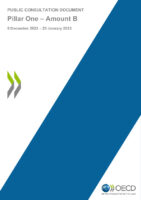
OECD Publishes Consultation Document on Amount B
On 9 December 2022 OECD published a consultation document on Amount B as part of the ongoing work on OECD’s two-pillar solution to address the tax challenges arising from the digitalisation of the economy. Amount B is one of the components of Pillar One and aims to simplify and streamline application of the arm’s length principle in regards to in-country baseline marketing and distribution activities. A particular concern of low capacity jurisdictions has been the relative unavailability of appropriate local market comparables through which arm’s length prices can be established. Amount B will address this issue by providing a basis to establish an arm’s length price in all cases using suitable comparables, wherever they are geographically drawn from. The consultation document outlines the main design elements of Amount B – scope, pricing methodology and the current status of discussions concerning an appropriate implementation framework. Deadline for submission of comments is 25 January 2023.

EU reaches agreement on Pillar 2 – Implementation in Member States no later than 31 December 2023
12 December 2022 the EU Council announced unanimous agreement among member states on the Commission’s proposal for a Directive ensuring a minimum effective tax rate of 15% for large multinationals with a turnover of at least €750 million. With the agreement, the EU will be among the first to implement Pillar II. The Council Directive includes a common set of rules on how to calculate the 15% effective minimum tax rate– so that this is properly and consistently applied across the EU. The rules will apply to multinational enterprise groups and large-scale domestic groups in the EU, with combined financial revenues of more than €750 million a year. They will apply to any large group, both domestic and international, with a parent company or a subsidiary situated in an EU Member State. If the minimum effective rate is not imposed by the country where the subsidiary company is based, there are provisions for the Member State of the parent company to apply a “top-up” tax. This Directive also ensures effective taxation in situations where the parent company is situated outside the EU in a low-tax country which does not apply equivalent rules.

Brazil issues Draft Legislation on implementation of the Arm’s Length Principle
28 December 2022 Brazil published draft legislation on implementation of the arm’s length principle as described in the OECD Transfer Pricing Guidelines. The new provisions came into effect on the date of publication and must be converted into law by the National Congress. The new transfer pricing regime will be optional for taxpayers for 2023 and mandatory as of 2024. Unofficial English Translation
The South African Revenue Service (SARS) issues Arm’s Length Guidance on Intra-Group Loans
17 January 2023 the South African Revenue Service (SARS) released an interpretation note titled “DETERMINATION OF THE TAXABLE INCOME OF CERTAIN PERSONS FROM INTERNATIONAL TRANSACTIONS: INTRA-GROUP LOANS” which provides guidance on how SARS will determine arm’s length pricing for intra-group loans. The Note also provides guidance on the consequences for a taxpayer if the amount of debt, the cost of debt or both are not arm’s length. According to the note an intra-group loan would be incorrectly priced if the amount of debt funding, the cost of the debt or both are excessive compared to what is arm’s length.
OECD publishes Guidance on the Handling of Multilateral MAPs and APAs
1 February 2023 OECD published guidance on Multilateral MAP and APAs. The Manual is intended as a guide to multilateral MAP and APA processes from both a legal and procedural perspective and provides tax administrations and taxpayers with information on the operation of these procedures and suggests different approaches based on the practices of jurisdictions, without imposing a set of binding rules. The Manual is divided into the following sections: Introduction: This section comprises the outline of the project, the challenges that generally arise in multilateral cases and the overview of experiences of Focus group members based on their responses to the survey. Basis for handling multilateral MAP and APA cases: This section contains guidance on the definition of a multilateral case, the legal basis for handling multilateral cases, the request filed in multilateral cases and the connection between access to multilateral procedures and the Action 14 minimum standard. Procedural aspects to consider in multilateral cases: This section contains guidance on approaching the other jurisdictions concerned in multilateral cases, possible approaches to discussions, the coordination of procedural matters, the modalities of discussions, the interaction of available domestic remedies or procedures with multilateral cases, the implementation of agreements arising from these cases, arbitration where there is no MAP agreement and the rights and the obligations and role of the taxpayer. Examples of multilateral cases: A number of representative, simplified examples of transactions that would generally benefit from multilateral solutions Ideal timeline for a typical multilateral case: Indicative timelines for each step of a multilateral MAP or APA case in line with the guidance provided in the Manual. The Manual allows tax administrations to explore whether implementation of these procedures is appropriate considering the circumstances of their own MAP and APA programmes and to consider whether the guidance therein may be incorporated in their domestic guidance on MAP or APA processes to provide additional clarity. The Manual also outlines the actions and cooperation expected from taxpayers to allow tax administrations to consider MAP and APA cases multilaterally.
Interpretation statement from the Inland Revenue of New Zealand on application of the general anti-avoidance provision
3 February 2023 the Inland Revenue of New Zealand issued an interpretation statement explaining the Commissioner’s view of the law on tax avoidance in New Zealand. It sets out the approach the Commissioner will take to the general anti-avoidance provisions in the Income Tax Act 2007 – ss BG 1 and s GA 1. Where s BG 1 applies, s GA 1 enables the Commissioner to make an adjustment to counteract a tax advantage obtained from or under a tax avoidance arrangement. The Supreme Court in Ben Nevis considered it desirable to settle the approach to the relationship between s BG 1 and the specific provisions in the rest of the Act. This approach is referred to as the Parliamentary contemplation test. The Parliamentary contemplation test was confirmed as the proper and authoritative approach to applying s BG 1 by the Supreme Court in Penny and Frucor. The statement is based on and reflects the view of the Supreme Court as set out in Ben Nevis, and applied in Penny and Frucor.

EU list of Non-Cooperative Tax Jurisdictions – Tax Havens
14 February 2023 the Council of the European Union published an updated list of non-cooperative tax jurisdictions. The British Virgin Islands, Costa Rica, the Marshall Islands and Russia have been added to the list, which now comprises 16 jurisdictions: American Samoa Anguilla Bahamas British Virgin Islands Costa Rica Fiji Guam Marshall Islands Palau Panama Russia Samoa Trinidad and Tobago Turks and Caicos Islands US Virgin Islands Vanuatu This revised EU list of non-cooperative tax jurisdictions includes countries that either have not engaged in a constructive dialogue with the EU on tax governance or have failed to deliver on their commitments to implement the necessary reforms. Those reforms should aim to comply with a set of objective tax good governance criteria, which include tax transparency, fair taxation and implementation of international standards designed to prevent tax base erosion and profit shifting. For the Marshall Islands, there are concerns that this jurisdiction which has a zero or only nominal rate of corporate income tax is attracting profits without real economic activity (criterion 2.2 of the EU list). In particular, the Marshall Islands were found to be lacking in the enforcement of economic substance requirements. The Marshall Islands have been listed already once, in 2018. British Virgin Islands are listed because they were found not to be sufficiently in compliance with the OECD standard on exchange of information on request (criterion 1.2). This is the first time this jurisdiction is listed. For the first time since the list was established, Costa Rica is included because it has not fulfilled its commitment to abolish or amend the harmful aspects of its foreign source income exemption regime (criterion 2.1). Russia is listed after the code of conduct group screened Russia’s new legislation adopted in 2022 against the good tax governance criteria of the code and found that Russia had not fulfilled its commitment to address the harmful aspects of a special regime for international holding companies (criterion 2.1). In addition, dialogue with Russia on matters related to taxation came to a standstill following the Russian aggression against Ukraine.
IRS publishes new interim Guidance on Review and Acceptance of APA Submissions
In a memorandum issued April 25, 2023, the IRS provides guidance to their employees of the Treaty and Transfer Pricing Operations practice area in the Large Business and International Division with respect to requests from taxpayers for an APA with the IRS. The guidance instructs IRS personnel on how to review and, where appropriate, accept taxpayer APA requests to align the processes for APAs to be consistent with IRS’ strategy and maximize the probability of successful, timely, and comprehensive resolution of transfer pricing issues for both taxpayers and the IRS. Visit IRS’ webpage for more information on the US Advance Pricing and Mutual Agreement Program.

Poland issues Tax clarifications on transfer pricing – No. 5: Resale Price Method
24 March 2023 the Polish Ministry of Finance issued Tax clarifications on transfer pricing No. 5: Resale Price Method The resale price method (RPM) is one of the traditional transaction methods and probably most useful where it is applied to distribution operations.. Application of the RPM for determining the price of a controlled transaction begins with the price at which a product that has been purchased from an associated enterprise is resold to an independent enterprise. This price (the resale price) is then reduced by an appropriate gross margin on this price (the “resale price margin”) representing the amount out of which the reseller would seek to cover its selling and other operating expenses and, in the light of the functions performed (taking into account assets used and risks assumed), make an appropriate profit. What is left after subtracting the gross margin can be regarded, after adjustment for other costs associated with the purchase of the product (e.g. customs duties), as an arm’s length price for the original transfer of property between the associated enterprises. The resale price method is described in: • Chapter II, Part II, Section C, paragraphs 2.27-2.44 of the OECD Guidelines; • Chapter 4.3 of the UN Handbook See the previous Polish clarifications on transfer pricing: No. 1 – Comparability Analyses and Documenation No. 2 – Transfer Pricing Adjustments No. 3 – CUP method No. 4 – TNMM Click here for unofficial English translation
Germany publishes draft legislation to implement the global minimum tax – OECD Pillar II
The German Federal Ministry of Finance issues draft law for the implementation of the EU Directive to ensure a global minimum level of taxation for multinational groups of companies and large domestic groups in the Union The aim of the draft law is to implement key elements of the international agreements on Pillar 2 of the so-called two-pillar solution. The post-taxation provisions contained therein are intended to ensure a global effective minimum taxation, to counteract harmful tax competition and aggressive tax structuring and thus to contribute to the promotion of tax justice and a level playing field. Click here for unofficial English translation
Canada plans to modernize and strengthen the general anti avoidance rule (GAAR)
According to the Canadian Budget 2023 the government will release for consultation draft legislative proposals to amend the general anti avoidance rule (GAAR) which was added to the Canadian Income Tax Act in section 245 back in 1988. If abusive tax avoidance is established, the GAAR applies to deny the tax benefit that was unfairly created. The GAAR has helped to tackle abusive tax avoidance in Canada but it requires modernizing to ensure its continued effectiveness. The following amendments to the GAAR is proposed: introducing a preamble (containing interpretive rules and statements of purpose); changing the avoidance transaction standard (from a “primary purpose” test to a “one of the main purposes” test); introducing an economic substance rule (indicators for lack in economic substance); introducing a penalty (25% of the amount of the tax benefit); and extending the reassessment period in certain circumstances (three-year extension to the normal reassessment period). The revised GAAR is expected to come into force as of 1 January 2024. See the relevant sections of the Canadian Budget 2023 below.
Malaysia issues new Transfer Pricing Rules for 2023
On 29 May 2002, Malaysia updated its existing TP rules. The new rules are largely in line with the OECD Transfer Pricing Guidelines, but there are minor differences. For example, the new rules state that the arm’s length range is defined as the range between the 37.5th and 62.5th percentiles of a data set. Furthermore, according to the new rules, the tax authorities may make adjustments to the median or any point above the median, even if a taxpayer’s price is already within the arm’s length range where there is a lower degree of comparability or comparability defects in the dataset. “13. Adjustment by Director General (1) Notwithstanding any other provision under these Rules, where the Director General has reason to believe that any price including the rate of interest imposed or would have been imposed in a controlled transaction is not at arm’s length, the Director General may make an adjustment to reflect the arm’s length price or arm’s length interest rate for that transaction by substituting or imputing the price or interest, as the case may be. (2) Where the price at which a controlled transaction entered by a person is— (a) within the arm’s length range, such price may be regarded to be the arm’s length price; or (b) outside the arm’s length range, the arm’s length price shall be taken to be the median. (3) For the purposes of paragraph (2)(a), the Director General may adjust the price of the controlled transaction to the median or any other point above median within the arm’s length range— (a) where the uncontrolled transaction is the kind which has a lesser degree of comparability; or (b) where any of the comparability defects cannot be quantified, identified, or adjusted. (4) For the purposes of adjustment made under subrule (1), the Director General may impose surcharge in accordance with subsection 140A(3C) of the Act. (5) For the purposes of this rule— “arm’s length range” means a range of figures or a single figure falling between the value of 37.5 percentile to 62.5 percentile of the data set and acceptable by the Director General in determining whether the arm’s length price has been applied in a controlled transaction and such range, upon compliance with rule 7, is derived from— (a) applying the same transfer pricing methodology to multiple comparable data; or (b) applying different method as determined under rule 6; “median” means the value at the mid-point of the arm’s length range” The new rules will have effect for the year of assessment 2023 and subsequent years. (English version on page 29 and forward)
Germany – Update to Transfer Pricing Provisions in the Foreign Tax Act (Außensteuergesetz)
On 27 March 2024, new paragraphs (3d) and (3e) were added to the German Foreign Tax Act (Außensteuergesetz – AStG) regarding intragroup financing. Paragraph (3d) concerns the determination of arm’s length interest rates, group vs. stand-alone rating and whether capital is treated as a loan or equity. Paragraph (3e) concerns the treatment of financing arrangements, i.e. cash pools, hedging, etc.
New German Administrative Principles on Transfer Pricing (BMF-AO-2023)
6 June 2023 Germany published it’s new updated administrative principles on transfer pricing. The new publication includes expanded guidance on transfers of functions (and valuation – see English translation) and financial transactions. With regard to the latter, reference is made to two recent decisions of the Federal Fiscal Court (BFH) on intra-group loans (BFH of 18 May 2021, I R 4/17, and of 13 January 2022, I R 15/21). With the exception of the new content on transfer of functions, the new principles can be applied retroactively by the tax authorities. Click here for an unofficial English translation of the German 2023 Administrative Principles on Transfer Pricing
Brazil publishes new updated 2023 transfer pricing legislation – aligned with OECD guidelines
14 June 2023 Brazil issued it’s new updated transfer pricing legislation, which is now aligned with OECD transfer pricing guidelines. Click here for unofficial English translation
Germany – Updated Administrative Principles on Transfer Pricing 2024
12 December 2024, the German Federal Ministry of Finance published updated administrative principles on transfer pricing 2024 (VWG VP 2024). The updates mainly concern the chapter on financial transactions, where paragraphs 3d and 3e have recently been added to the AStG. Paragraph 3d concerns the determination of arm’s length interest rates, group or stand-alone rating and whether capital should be treated as a loan or equity, and paragraph 3e concerns the treatment of financing arrangements, i.e. cash pools, hedging, etc. New guidance is also provided on the application of OECD Pillar 1 – Amount B. Click here for an unofficial English Translation
Draft Guidance on recent Updates to German TP provisions on Intra-Group Financing
14 August 2024, the Federal Ministry of Finance sent revised administrative principles for transfer prices 2023 dated 6 June 2023 regarding the topic of intra-group financing, which, among other things, takes into account new paragraphs 3d and 3e in the German TP provisions. An opportunity to comment on the draft will be available until 6 September 2024. Paragraphs 3d and 3e were recently added to the German Foreign Tax Act (AStG). Paragraph 3d concerns the determination of arm’s length interest rates, group or stand-alone rating and whether capital should be treated as a loan or equity and paragraph 3e concerns the treatment of financing arrangements, i.e. cash pools, hedging, etc. Click here for an unofficial English Translation

138 countries and jurisdictions agree historic milestone to implement OECD’s global tax deal
12 July 2023 138 members of the OECD/G20 Inclusive Framework on Base Erosion and Profit Shifting (BEPS) – representing over 90% of global GDP – agreed an Outcome Statement recognising the significant progress made and allowing countries and jurisdictions to move forward with historic, major reform of the international tax system. The Two‐Pillar Solution to Address the Tax Challenges Arising from the Digitalisation of the Economy will ensure a fairer distribution of profits and taxing rights among countries and jurisdictions with respect to the world’s largest Multinational Enterprises (MNEs). The Outcome Statement agreed at the 15th Meeting of the Inclusive Framework follows 20 months of intense technical negotiations by delegates to continue the work to implement the Two Pillar Solution. It reflects collaboration and compromise among all jurisdictions – small and large, developing and developed – during negotiations by Inclusive Framework members since October 2021. The Outcome Statement summarises the package of deliverables developed by the Inclusive Framework to address the remaining elements of the Two‐Pillar Solution: A text of a Multilateral Convention (MLC) developed by the Inclusive Framework, which allows jurisdictions to reallocate and exercise a domestic taxing right over a portion of MNE residual profits (Amount A of Pillar One). The Inclusive Framework will publish the text of the MLC once it has been prepared for signature, upon resolution of a small number of specific items, as a few jurisdictions have expressed concerns with some specific items in the MLC; A proposed framework for the simplified and streamlined application of the arm’s length principle to in-country baseline marketing and distribution activities (Amount B of Pillar One); where input from stakeholders is requested on certain aspects prior to finalisation; The Subject-to-Tax Rule (STTR) together with its implementation framework, which will enable developing countries to update bilateral tax treaties to “tax back” income on certain intra-group income where such income is subject to low or nominal taxation in the other jurisdiction; A comprehensive action plan will be prepared by the OECD to support the swift and co-ordinated implementation of the Two-Pillar Solution, coordinating with regional and international organisations. In a significant development since October 2021, 138 countries and jurisdictions have also agreed in the Outcome Statement to refrain from imposing newly enacted digital services taxes or relevant similar measures on any company before 31 December 2024, or the entry into force of the MLC if earlier, provided the signature of the MLC has made sufficient progress by the end of the year. This commitment is made in recognition of the progress made to date and the need to prevent disruption or delay of the ratification of the MLC. “The Two-Pillar Solution will provide stability for the international tax system, making it fairer and work better in an increasingly digitalised and globalised world economy,” OECD Secretary-General Mathias Cormann said. “We have all been working intensively on the technical details and on the implementation arrangements that are necessary to make the Two-Pillar Solution a reality. The agreement reached yesterday proves that despite the challenges and compromises along the way, multilateral dialogue works and can deliver results to tackle shared challenges requiring shared solutions. This work is critical to governments and our economies – ultimately, to be able to raise the necessary revenue to fund the essential public goods and services for their citizens.”
Common Errors made in Country-by-Country reports
On 23 May 2024, the OECD issued guidance on common errors made by multinational enterprise (MNE) groups when preparing their country-by-country (CbC) reports. These reports contain valuable information on the global allocation of income, taxes paid, and the location of economic activity among the tax jurisdictions in which an MNE group operates. This information can be used for a high-level transfer pricing risk assessment, the assessment of other BEPS-related risks, and economic and statistical analysis, if appropriate. However, this information can only be used effectively for these purposes if the data in CbC reports is robust and accurate. Tax administrations have encountered a number of errors in the data contained in CbC reports filed to date, and the new guidance describes the most common of these.
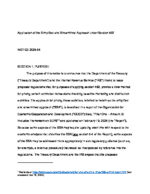
US Notice on application of the Simplified and Streamlined Approach
16 December 2024, the US Treasury Department and the Internal Revenue Service issued a Notice announcing their intention to issue regulations that would provide a new method under the US tranfer pricing rules in Section 482 for pricing certain controlled transactions that involve baseline marketing and distribution activities. The new method, referred to in the US notice 2025-04 as the Simplified and Streamlined Approach (“SSA”), is based on OECD’s Pillar One – Amount B report from February 2024.

Poland issues Tax clarifications on transfer pricing – No. 6: Cost Plus Method
September 29, 2023 the Polish Ministry of Finance has published tax explanations regarding transfer pricing No. 6 regarding the cost-plus method. The purpose of the explanations is to present practical aspects related to the use of the cost plus method. The explanations take into account the recommendations of the Transfer Pricing Forum of September 28, 2021 regarding the description of the cost plus method and comments submitted as part of the tax consultations. The cost-plus method is described in OECD and UN documents: Chapter II, Part II, Section D, paragraphs 2.45-2.61 of the OECD Guidelines; Chapter 4.4 of the UN Handbook See the previous Polish clarifications on transfer pricing: No. 1 – Comparability Analyses and Documenation No. 2 – Transfer Pricing Adjustments No. 3 – CUP method No. 4 – TNMM No. 5 – Resale Price Method Click here for unofficial English translation
FTA Article on Swiss Transfer Pricing Legislation and Practices as of 1 January 2024
The Swiss Federal Tax Authorities have published an Article on the status of transfer pricing legislation in Switzerland as of 1 January 2024. The Article describes the existing legal basis for the application of the arm’s length principle in Switzerland and reference is made to the OECD Transfer Pricing Guidelines as well as to Swiss administrative practice, circulars and case law. The Article highlights the importance of the comparability analysis and focuses on certain aspects of intra-group services, intangibles and financial transactions. With regard to transfer pricing documentation, the Article explains that Switzerland only requires country-by-country reporting. However, it also states that a Swiss taxpayer has a duty to cooperate with the tax authorities, which may involve demonstrating arm’s length pricing of controlled transactions. The official Article is only available in French and German. An unofficial English version of the Article is provided below.
Malta Publishes Local Guidance on Transfer Pricing
On January 19, 2024, the Maltese Commissioner of Taxes and Customs published local guidelines in relation to the transfer pricing rules introduced in Malta in November 2022 by Legal Notice 284 of 2022. The local guidelines refer to the OECD Transfer Pricing Guidelines 2022 in relation to the application of transfer pricing methods, comparability analysis, transfer pricing documentation, etc.
US publishes Memorandum on the Effect of Group Membership on Financial Transactions
On 29 December 2023, the Office of Chief Counsel of the IRS issued a memorandum (AM 2023-008) on the effect of group membership on financial transactions. The memorandum answers the following question: “May the Service consider group membership in determining the arm’s length rate of interest chargeable for intragroup loans and making a section 482 adjustment?” The answer given in the memorandum is “Yes. Under the section 482 regulations, the arm’s length rate of interest on an intragroup loan to a controlled borrower is generally the rate at which that borrower could realistically obtain alternative financing from an unrelated party. Thus, if an unrelated lender would consider group membership in establishing financing terms available to the borrower, and such third-party financing is realistically available, then the Service may adjust the interest rate in a controlled lending transaction to reflect group membership.” The rationale in the memorandum refers to Treas. Reg. §§ 1.482-1, 1.482-2, 1.482-9, OECD TPG 7.13 and 10.76-80 and the realistic alternatives/realistically available options principle.
Brazil publishes comprehensive normative instructions for its new transfer pricing rules
29 September 2023 Brazil published normative instructions (IN RFB nº 2.161/23) for its new transfer pricing rules, which will apply from FY 2024 onwards. Brazil’s transfer pricing legislation is now in line with the OECD Transfer Pricing Guidelines. In fact, the new legislation is the result of a joint project between the Brazilian Federal Revenue Service (Receita Federal do Brasil) and the OECD. The normative instructions deal with the general aspects of the new law, which form the basic part of the new system and apply to all transactions falling within its scope. It addresses practical issues in the application of the new regime and provides simplification measures for some transactions as well as for the fulfilment of ancillary obligations. For companies wishing to apply the new rules for FY 2023, the opt-in deadline has been extended to December. These taxpayers will have to fill in a special form and make their definitive choice between September and December. In December 2022, Provisional Measure 1,152 was issued, significantly modifying Brazilian transfer pricing rules. In June 2023, the Provisional Measure was converted into Law 14.596/23. Click here for unofficial English translation
OECD releases text of the new MLC to Implement Amount A of Pillar One
11 October 2023 the OECD/G20 Inclusive Framework has released the text of a new multilateral convention that updates the international tax framework to co-ordinate a reallocation of taxing rights to market jurisdictions, improve tax certainty, and remove digital service taxes. The Multilateral Convention to Implement Amount A of Pillar One (the MLC) reflects the current consensus achieved among members of the Inclusive Framework. Amount A of Pillar One co-ordinates a reallocation of taxing rights to market jurisdictions with respect to a share of the profits of the largest and most profitable multinational enterprises (MNEs) operating in their markets, regardless of their physical presence. It also ensures the repeal and prevents the proliferation of digital services taxes and relevant similar measures, secures mechanisms to avoid double taxation, and enhances stability and certainty in the international tax system. Accompanied by an Explanatory Statement and the Understanding on the Application of Certainty of Amount A, the MLC provides for a co-ordinated system of taxation and sets out the substantive features necessary for it to be prepared for signature, including its scope and operation. The MLC also includes several provisions designed to address the unique circumstances of developing Inclusive Framework members.
United Arab Emirates issues comprehensive Transfer Pricing Guide
23 October 2023, the United Arab Emirates issued a comprehensive practical Transfer Pricing Guide. The guide is designed to provide general guidance on the Transfer Pricing regime in the UAE with a view to making the provisions of the Transfer Pricing regulations as understandable as possible to readers. UAE’s Transfer Pricing regulations are contained in Federal Decree-Law No. 47 of 2022 on the Taxation of Corporations and Businesses, Chapter 10.
OECD publishes Guidance on Pricing of Minerals
6 November 2023 OECD published a transfer pricing framework on determining the price of minerals. The framework provide guidance for developing countries to accurately delineate the transaction and price mineral sales on an arm’s length basis. Specifically, it identifies the primary economic factors that influence the pricing of minerals using transfer pricing principles. In particular the guidance offers a framework on how to use transfer pricing principles to apply the Comparable Uncontrolled Price method, including identifying the primary economic factors that influence the price of minerals (“mineral pricing framework”) to ensure that developing countries are able to tax mineral exports appropriately. The first section of the practice note sets out a high-level summary of the mining value chain and identifies areas where related-party transactions could pose a risk to tax revenues by taxpayers inappropriately applying the arm’s length principle or not applying it at all. The second section of the practice note specifically addresses transfer pricing risks associated with mineral pricing.
OECD releases the report on Amount B of Pillar One
On 19 February 2024, the OECD/G20 Inclusive Framework on BEPS released the report on Amount B of Pillar One, which provides a simplified and streamlined approach to the application of the arm’s length principle to baseline marketing and distribution activities, with a particular focus on the needs of low-capacity countries. Drawing from existing principles in the OECD Transfer Pricing Guidelines, Amount B provides a simplified and streamlined pricing framework that determines a return on sales for eligible distributors. This framework is expected to reduce transfer pricing disputes, compliance costs, and enhance tax certainty for tax administrations and taxpayers alike. Low-capacity jurisdictions facing limited resources and data availability will especially benefit from the administrative simplification provided by Amount B. The report, which introduces two options for implementation for jurisdictions that opt into the simplified and streamlined approach from January 2025, describes the circumstances under which a distributor is within scope of Amount B including cases where it also performs certain non-distribution activities, such as manufacturing. It also sets out the activities that may exclude a distributor from the scope of the simplified and streamlined approach, such as the distribution of commodities or digital goods. The report is released in line with the July 2023 Outcome Statement on the Two-Pillar Solution to Address the Tax Challenges Arising from the Digitalisation of the Economy, with further work on the interdependence of Amount B and Amount A under Pillar One to be undertaken prior to the signing and entry into force of the Multilateral Convention. The inclusion of the Amount B guidance into the OECD Transfer Pricing Guidelines is accompanied by conforming changes to the Commentary on Article 25 of the OECD Model Tax Convention. The conforming changes signpost specific language relating to tax certainty and the elimination of double taxation included in the report on Amount B and are intended to ensure optionality is preserved in all dispute resolution mechanisms for non-adopting jurisdictions. In particular, the amendments to the Commentary on Article 25 direct States and taxpayers to have regard to and follow specific directions within the report on Amount B where relevant to issues being considered under mutual agreement and MAP arbitration procedures. The conforming changes were prepared by Working Party 1, approved by the Inclusive Framework and will be submitted shortly for approval to the OECD Council prior to publication.

OECD Publishes Manual on Bilateral Advance Pricing Arrangement
On 28 September 2022 OECD published a new manual for entering bilateral advance pricing arrangement (APA’s) which has been approved by the Inclusive Framework on BEPS, as well as all members of the FTA, on 6 July 2022. The Bilateral Advance Pricing Arrangement Manual (“BAPAM” or “Manual”) is intended as a guide to tax administrations and taxpayers for streamlining the bilateral APA process. In addition to detailing several Best Practices for engaging in bilateral APAs, it also includes practical resources for tax administrations and taxpayers, such as templates and examples. It provides tax administrations and taxpayers with basic information on the operation of bilateral APAs (“BAPAs”) and identifies best practices for BAPAs without imposing a set of binding rules upon jurisdictions. The best practices identified in the Manual aim to streamline the BAPA process through: Mitigating delays created by differences in the BAPA processes in each jurisdiction, where possible. Avoiding information asymmetries between competent authorities by ensuring they have access to the same information, in the same form and at the same time. Increasing transparency between competent authorities and taxpayers throughout the BAPA process. Ensuring that there are realistic expectations for competent authorities and taxpayers at each stage of the BAPA process as to the resources required and the expected timeframes to come to an agreement. The Manual does not modify, restrict or expand any rights or obligations contained in the provision of any tax convention, the OECD MTC, or the OECD TPG. To the extent any content in the Manual appear to conflict with a tax treaty, the OECD Model Tax Convention, its Commentary, the OECD Transfer Pricing Guidelines or the Action 14 Final Report, the latter document or guidance is controlling. “Best practice” is the term used in this Manual to describe what is generally thought to be the most appropriate manner to deal with a BAPA process or procedural issue. The best practices contained in the Manual are based on those best practices already undertaken by jurisdictions or put forward by taxpayers and jurisdictions as part of a consultation process rather than being developed from a unified single BAPA programme. Although taxpayers and tax administrations should ideally strive towards implementing these best practices, it is recognised that it may not always be possible to apply a best practice as described in the Manual or there may be situations where their application may not be appropriate.
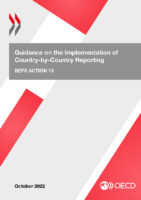
OECD Publishes Updated Guidance on CbC Reporting
On 14 October 2022 OECD published updated guidance on CbC reporting. The guidance contains definitions of items in the CbC reporting template – revenue, related parties, tax accrued and paid, fair value accounting, positive and negative figures etc. Issued related to particular reporting entities is also addressed (investment funds, major shareholding, deemed listing provisions and permanent establishment information. Guidance is provided on common issues such as currency fluctuations, definition of consolidated revenue, long and short accounting periods, mergers – demergers and acquisitions, and errors made by MNE groups in preparing CbC reports. And finally the updated guidance addresses issues related to the mechanism for sharing CbCR between tax authorities.
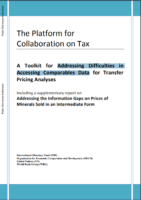
Accessing Comparables Data – A Toolkit on Comparability and Mineral pricing
The Platform for Collaboration on Tax (IMF, OECD, UN and the WBG) has published a toolkit for addressing difficulties in accessing comparables Data for Transfer Pricing Analyses. The Toolkit Includes a supplementary report on addressing the information gaps on prices of Minerals Sold in an intermediate form.
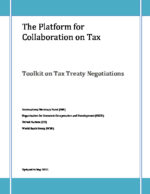
A Toolkit on Tax Treaty Negotiations
The Platform for Collaboration on Tax (IMF, OECD, UN and the WBG) has published a toolkit on Tax Treaty Negotiations. The Toolkit represents a joint effort to provide capacity-building support to developing countries on tax treaty negotiation, building on previous contributions and reducing duplication and inconsistencies. It provides tax officials who have little or no experience in tax treaty negotiation with the tools they need to implement some of the guidance in the UN Manual. It does so by building on Section II of the UN Manual, which sets out how to conduct a tax treaty negotiation in all its phases (preparation, conduct and follow-up), complementing it with a set of tools and resources.
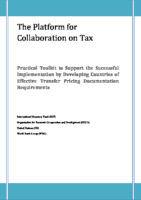
A Toolkit on Implementation of Effective Transfer Pricing Documentation Requirements
The Platform for Collaboration on Tax (IMF, OECD, UN and the WBG) has published a toolkit on implementation of effective transfer pricing documentation requirements.
Germany adds new TP-Provisions to the Foreign Tax Act (Außensteuergesetz)
On 27 March 2024, new paragraphs (3d) and (3e) were added to the German Foreign Tax Act (Außensteuergesetz – AStG) regarding intragroup financing. Paragraph (3d) concerns the determination of arm’s length interest rates, group vs. stand-alone rating and whether capital is treated as a loan or equity. Paragraph (3e) concerns the treatment of financing arrangements, i.e. cash pools, hedging, etc.

EU Commission proposes to simplify tax rules – and harmonise transfer pricing rules across the EU
12 September 2023, the European Commission published a new proposal to simplify tax rules and harmonise transfer pricing rules across the EU to reduce compliance costs for cross-border businesses. According to the press release, the proposal, called “Business in Europe: Framework for Income Taxation” (BEFIT), will make life easier for both businesses and tax authorities by introducing a new, single set of rules to determine the tax base of groups of companies. This will reduce compliance costs for large businesses who operate in more than one Member State and make it easier for national tax authorities to determine which taxes are rightly due. The new, simpler rules could reduce tax compliance costs for businesses operating in the EU by up to 65%. BEFIT will mean that: Companies that are members of the same group will calculate their tax base in accordance with a common set of rules. The tax bases of all members of the group will be aggregated into one single tax base. Each member of the BEFIT group will have a percentage of the aggregated tax base calculated on the basis of the average of the taxable results in the previous three fiscal years. Dealing with 27 different national tax systems, each with its specific rules, makes it costly for companies when it comes to tax compliance. This discourages cross-border investment in the EU, putting European businesses at a competitive disadvantage compared to companies elsewhere in the world. In more detail The proposal builds on the OECD/G20 international tax agreement on a global minimum level of taxation, and the Pillar Two Directive adopted at the end of 2022. The new rules will be mandatory for groups operating in the EU with an annual combined revenue of at least €750 million, and where the ultimate parent entity holds at least 75% of the ownership rights or of the rights giving entitlement to profit. The rules will be discretionary for smaller groups, which may choose to opt in as long as they prepare consolidated financial statements. This might be of particular interest to SMEs. Transfer pricing The package also includes a proposal aiming at harmonising transfer pricing rules within the EU and ensuring a common approach to transfer pricing. The proposal will increase tax certainty and mitigate the risk of litigation and double taxation. The Directive will also further reduce the opportunities for companies to use transfer pricing for aggressive tax planning purposes. Next steps Once adopted by the Council, the proposals should come into force on 1 July 2028 (for BEFIT) and as of 1 January 2026 (for the transfer pricing proposal). For more information Questions and Answers on BEFIT and transfer pricing BEFIT legal proposal Transfer Pricing BEFIT Factsheet
OECD Guidance on the Pricing of Minerals
On 12 August 2024, a report on pricing of minerals was released by the OECD. The report (Determining the Price of Minerals) is specifically targeted the transfer pricing-framework for pricing of Lithium, but also contains arm’s length principles for pricing of commodities in general. Abstract “In the mining sector, government revenue depends on mineral products being priced and measured accurately. This can be especially complex for semi-processed minerals such as lithium, which is primarily used for battery production. The schedule presented in this report applies the mineral pricing framework – as documented in the joint OECD/IGF work Determining the Price of Minerals: A Transfer Pricing Framework – to identify the primary economic factors that influence the price of lithium in applying the Comparable Uncontrolled Price method and ensure that developing countries are able to tax lithium exports appropriately.”
OECD releases New Set of Administrative Guidance on GloBE Model Rules
17 June 2024 OECD released a fourth set of Administrative Guidance on the Global AntiBase Erosion Model Rules (Pillar Two), in order to further clarify technical issues under the GloBE Rules. The Administrative Guidance will eventually be incorporated into the Commentary to the GloBE Model Rules. Administrative Guidance on the GloBE rules has also previously been release in July 2023, December 2023, and February 2024.
OECD releases lists of qualifying and covered jurisdictions under Amount B
On 17 June 2024, additional guidance and lists of qualifying and coverred jurisdictions under Amount B was released by the OECD. The additional guidance includes: The definitions of qualifying jurisdictions within the meaning of section 5.2 and 5.3 of the Amount B guidance. These definitions will facilitate adjustments to the return calculated under the simplified and streamlined approach for tested parties located in those qualifying jurisdictions. The respective definitions are now incorporated into the Amount B guidance in the annex to Chapter IV of the OECD Transfer Pricing Guidelines. The definition of covered jurisdictions within scope of the political commitment on Amount B. That political commitment recognises that subject to their domestic legislation and administrative practices, members of the Inclusive Framework commit to respect the outcome determined under the simplified and streamlined approach to in-scope transactions where such an approach is applied by a covered jurisdiction and to take all reasonable steps to relieve potential double taxation that may arise from the application of the simplified and streamlined approach by a covered jurisdiction where there is a bilateral tax treaty in effect between the relevant jurisdictions. The approach developed to produce the list of covered jurisdictions facilitates tax certainty for jurisdictions most interested in implementing Amount B from 1 January 2025. Note that an expression of interest in applying Amount B does not necessarily mean that a jurisdiction will proceed to implement it. Further work on the Pillar One package, including the Amount B framework, is still ongoing as indicated in the Statement by the Co-Chairs of the Inclusive Framework on 30 May 2024.
United Arab Emirates issues comprehensive Transfer Pricing Guide
On 23 October 2023, the United Arab Emirates issued a comprehensive practical Transfer Pricing Guide. The guide is designed to provide general guidance on the Transfer Pricing regime in the UAE with a view to making the provisions of the Transfer Pricing regulations as understandable as possible to readers. UAE’s Transfer Pricing regulations are contained in Federal Decree-Law No. 47 of 2022 on the Taxation of Corporations and Businesses, Chapter 10.
Nepal issues Guidelines on Transfer Pricing
In October 2024, the Department of Inland Revenue in Nepal issued local Guidelines on Transfer Pricing. Section 33 of the Nepalese Income Tax Act, 2058, includes provisions related to transfer pricing and other arrangements between related parties. Under this section, the Inland Revenue Department may, in determining income, adjust or allocate amounts by including or excluding certain transactions to calculate taxable income and tax based on the arm’s length principle. The department also has the authority to recharacterize distributions, allocations, or allocations of income between related parties. The provisions under section 33 apply to the transactions between related parties based on the transfer pricing methods determined by the department. The guidelines applies for the fiscal year 2024/2025 and forward. The content is devided into the following sections 1 Introduction 2 Definitions 3 Transfer Pricing Determination and Arm’s Length Principle 4 Comparability Analysis 5 Arm’s Length Pricing Methods 6 Documentation Related to Transfer Pricing Determination 7 Administration of Transfer Pricing Determination Annex 1 – List of Documents to be Maintained by the Taxpayer Related to Transfer Pricing Determination Annex 2 – Certified Details Submitted by the Auditor in the Income Return Form
Kenya issues Guidance on the Mutual Agreement Procedure
Kenya’s Double Taxation Agreements (DTAs) contain an Article on Mutual Agreement Procedure (MAP), typically Article 25, which allows two Contracting States to interact with each other with the intent of resolving international tax disputes. These disputes arise from situations where a taxpayer is of the view that they have been subjected to taxation contrary to the provisions of the DTA or from inconsistencies in the interpretation and application of the DTA. The Article also allows for consultation on the elimination of double taxation in cases not provided for in the DTA. The purpose of the Guidance is to set out the MAP process through which taxpayers can request assistance from the Kenyan Competent Authority to resolve disputes arising from taxation that they consider not to be in accordance with the provisions of the relevant DTA.
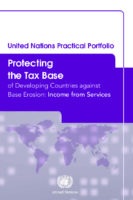
January 2017: United Nations Practical Portfolio – Income from Services
In January 2017, the UN published a practical portfolio with guidance on how to protect a country’s domestic tax base from base erosion and profit shifting through reduced income from services or excessive expences for services.
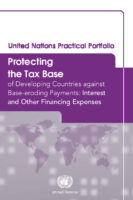
January 2017: United Nations Practical Portfolio – Interest and Other Financing Expenses
In January 2017, the UN published a practical portfolio with guidance on how to protect a country’s domestic tax base from base erosion and profit shifting through payments of interest and other financial expenses.

US Investigations into Digital Service Taxes
Washington, DC – The United States Trade Representative announced today that his office is beginning investigations into digital services taxes that have been adopted or are being considered by a number of our trading partners. The investigations will be conducted under Section 301 of the 1974 Trade Act. This provision gives the USTR broad authority to investigate and respond to a foreign country’s action which may be unfair or discriminatory and negatively affect U.S. Commerce. “President Trump is concerned that many of our trading partners are adopting tax schemes designed to unfairly target our companies,” said USTR Robert Lighthizer. “We are prepared to take all appropriate action to defend our businesses and workers against any such discrimination.”
Altera asking the US Supreme Court for a judicial review of the 2019 Decision from the U.S. Court of Appeals concerning the validity of IRS regs. on CCAs
Altera has asked the US Supreme Court for a judicial review of the Decision from the U.S. Court of Appeals for the Ninth Circuit over the validity of Internal Revenue Service regulations that requires related companies to share the cost of stock-based employee compensation when shifting their intangible assets abroad applying US Cost Sharing regulations. In the decision a divided panel in the Court of Appeal upheld the regulation as “permissible” and therefore entitled to deference under Chevron, U.S.A., Inc. v. Natural Resources Defense Council, Inc., 467 U.S. 837 (1984). In the Petition Altera presents three questions: 1. Whether the Treasury Department’s regulation is arbitrary and capricious and thus invalid under the Administrative Procedure Act, 5 U.S.C. 551 et seq. 2. Whether, under SEC v. Chenery Corp., 332 U.S. 194 (1947), the regulation may be upheld on a rationale the agency never advanced during rulemaking. 3. Whether a procedurally defective regulation may be upheld under Chevron on the ground that the agency has offered a “permissible” interpretation of the statute in litigation. Under the third bullit Altera argues that the Chevron doctrin was applied erroneously by the Court of Appeals. The Chevron doctrin states that an agency is allowed a “permissible” interpretation where statutes are not sufficiently clear. Excerps from the 1984 Chevron case: "In these cases the Administrator's interpretation represents a reasonable accommodation of manifestly competing interests and is entitled to deference: the regulatory scheme is technical and complex, the agency considered the matter in a detailed and reasoned fashion, and the decision involves reconciling conflicting policies. Congress intended to accommodate both interests, but did not do so itself on the level of specificity presented by these cases. Perhaps that body consciously desired the Administrator to strike the balance at this level, thinking that those with great expertise and charged with responsibility for administering the provision would be in a better position to do so; perhaps it simply did not consider the question at this level; and perhaps Congress was unable to forge a coalition on either side of the question, and those on each side decided to take their chances with the scheme devised by the agency. For judicial purposes, it matters not which of these things occurred. Judges are not experts in the field, and are not part of either political branch of the Government. Courts must, in some cases, reconcile competing political interests, but not on the basis of the judges' personal policy preferences. In contrast, an agency to which Congress has delegated policymaking responsibilities may, within the limits of that delegation, properly rely upon the incumbent administration's views of wise policy to inform its judgments. While agencies are not directly accountable to the people, the Chief Executive is, and it is entirely appropriate for this political branch of the Government to make such policy choices-resolving the competing interests which Congress itself either inadvertently did not resolve, or intentionally left to agency charged with the administration of the statute in light of everyday realities. When a challenge to an agency construction of a statutory provision, fairly conceptualized, really centers on the wisdom of the agency's policy, rather than whether it is a reasonable choice within a gap left open by Congress, the challenge must fail. In such a case, federal judges - who have no constituency - have a duty to respect legitimate policy choices made by those who do. The responsibilities for assessing the wisdom of such policy choices and resolving the struggle between competing views of the public interest are not judicial ones: "Our Constitution vests such responsibilities in the political branches." TVA v. Hill, 437 U. S. 153, 195 (1978). We hold that the EPA's definition of the term "source" is a permissible construction of the statute which seeks to accommodate progress in reducing air pollution with economic growth. "The Regulations which the Adminstrator has adopted provide what the agency could allowably view as ... [an] effective reconciliation of these twofold ends" United States v. Shimer, 367 U. S., at 383." Altera ends the partition with the following statement: “The Ninth Circuit permitted a startling departure from accepted rules of administrative law, and its expansion of Chevron validates the concerns many Justices have raised about that doctrine. The Tax Court rejected the agency’s position in an opinion that was striking for its “uncommon unanimity and severity of censure,” yet the court of appeals simply “assume[d] away” the regulation’s problems, “send[ing] a signal that executive agencies can bypass proper notice-and- comment procedures as long as they come up with a clever post-hoc rationalization by the time their rules are litigated.” App., infra, 160a, 165a, 167a (Smith, J., dissenting from denial of rehearing). It is time for this Court to step in.”
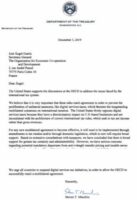
US response to OECDs Unified Approach
Letter from the US treasury to the OECD concerning the proposed Unified Approach on taxation of the Digital Economy, and the reply to the letter from the OECD.

Commission opens in-depth investigation into tax treatment of Huhtamäki in Luxembourg
The European Commission has now opened an in-depth investigation to examine whether tax rulings granted by Luxembourg to Finnish food and drink packaging company Huhtamäki may have given the company an unfair advantage over its competitors, in breach of EU State Aid rules. Margrethe Vestager, Commissioner in charge of competition policy, said: “Member States should not allow companies to set up arrangements that unduly reduce their taxable profits and give them an unfair advantage over their competitors. The Commission will carefully investigate Huhtamäki’s tax treatment in Luxembourg to assess whether it is in line with EU State aid rules.” The Commission’s formal investigation concerns three tax rulings issued by Luxembourg to the Luxembourg-based company Huhtalux S.à.r.l. in 2009, 2012 and 2013. The 2009 tax ruling was disclosed as part of the “Luxleaks” investigation led by the International Consortium of Investigative Journalists in 2014. Huhtalux is part of the Huhtamäki group, which is headquartered in Finland. Huhtamäki is a company active in consumer packaging, notably in food and food service packaging in Europe, Asia and Australia. Huhtalux carries out intra-group financing activities. It receives interest-free loans from another company of the Huhtamäki group based in Ireland. These funds are then used by Huhtalux to finance other Huhtamäki group companies through interest-bearing loans. The three tax rulings issued by Luxembourg allow Huhtalux to unilaterally deductfrom its taxable base fictitious interest payments for the interest-free loans it receives. According to Luxembourg, these fictitious expenses correspond to interest payments that an independent third party in the market would have demanded for the loans that Huhtalux receives. However, Huhtalux does not pay any such interest. These deductions reduce Huhtalux’s taxable base and, as a result, the company is taxed on a substantially smaller profit. The Commission is concerned that Luxembourg has accepted a unilateral downward adjustment of Huhtalux’s taxable base that may grant the company a selective advantage. This is because it would allow the group to pay less tax than other stand-alone or group companies whose transactions are priced in accordance with market terms. If confirmed, this would amount to illegal State aid.

The EU Anti Tax Avoidance Package – Anti Tax Avoidance Directives (ATAD I & II) and Other Measures
Anti Tax Avoidance measures are now beeing implemented across the EU with effect as of 1 January 2019. The EU Anti Tax Avoidance Package (ATAP) was issued by the European Commission in 2016 to counter tax avoidance behavior of MNEs in the EU and to align tax payments with value creation. The package includes the Anti-Tax Avoidance Directive, an amending Directive as regards hybrid mismatches with third countries, and four Other measures. ATAD I The Anti-Tax Avoidance Directive (ATAD), COUNCIL DIRECTIVE (EU) 2016/1164 of 12 July 2016, introduces five anti-abuse measures, against tax avoidance practices that directly affect the functioning of the internal market. 1) Interest Limitation Rule – Reduce profitshifting via exessive interest payments (Article 4) 2) Exit Taxation – Prevent tax motivated movement of valuable business assets (eg. intangibles) across borders (Article 5) 3) General Anti-Avoidance Rule (GAAR) – Discourage Artificial Arrangements (Article 6) 4) Controlled Foreign Company (CFC) – Reduce profits shifting to low tax jurisdictions (Article 7, 8) 5) Hybrid Mismatch Rule – Reduce Hybrid Mismatch Possibilities (Article 9 + ATAD II) The first measure, interest limitation rule aims to prevent profitshifting activities that take place via exessive interest payments . This rule restricts deductibility of interest expenses and similar payments from the tax base. The second measure, exit taxation, deals with cases where the tax base (eg. valuable intangible assets) is moved across borders. The third measure is the general antiavoidance rule (GAAR) which allows countries to tackle artificial tax arrangements not govened by rational economic reasons. The fourth measure is the controlled foreign company (CFC) rule, which is designed to deter profit-shifting to low-tax countries. The fifth measure, the rule on hybrid mismatches, aims to limit cases of double non-taxation and assymetric deductions resulting from discrepancies between different tax systems. ATAD II ATAD II, COUNCIL DIRECTIVE (EU) 2017/952) of 29 May 2017, an amending Directive as regards hybrid mismatches with third countries, contains a set of additional rules to neutralize hybrid mismatches where at least one of the parties is a corporate taxpayer in an EU Member State, thus expanding the application to Non-EU countries. The second directive also addresses hybrid permanent establishment (PE) mismatches, hybrid transfers, imported mismatches, reverse hybrid mismatches and dual resident mismatches. (Article 9, 9a and 9b) Other Measures Other measures included in the Anti Tax Avoidance Package Package are mainly aimed at sharing information and improving knowledge among EU Member States. 1) Country-by-Country Reporting (CbCR) – Improve Transparency (EU Directives on Administrative cooporation in the field of taxation) 2) Recommendation on Tax Treaties – Address Treaty Abuses 3) External Strategy – More Coherent Dealing with Third Countries 4) Study on Aggressive Tax Planning – Improve Knowledge (2015 Report on Structures of Aggressive Tax Planning and Indicators and 2017 Report on Aggressive Tax Planning Indicators) The Country-by-Country Reporting (CbCR) requirement introduces a reporting requirement on global income allocations of MNEs to increase transparency and provide Member States with information to detect and prevent tax avoidance schemes. The Recommendation on Tax Treaties provides Member States with information on how to design their tax treaties in order to minimise aggressive tax-planning in ways that are in line with EU laws. The External Strategy provides a coherent way for EU Member States to work with third countries, for instance by creating a common EU black list of Low Tax Jurisdictions . The Study on Aggressive Tax Planning investigates corporate tax rules in Member States that are or may be used in aggressive tax-planning strategies. Implementation and Effect Most of the measures introduced in ATAD I are now implemented and in effect as of 1 January 2019. ATAD II, addressing hybrid mismatches with Non-EU countries, is also being implemented and will be in effect as of 1 January 2020. A Non official version of the 2016 EU Anti Tax Avoidance Directive with the 2017 Amendments
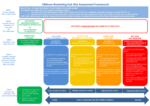
Marketing and Procurement Hubs – Tax Avoidance
The Australian Taxation Office has issued new guidance for multinational groups using offshore marketing- and procurment hubs for tax avoidance purposes. The guidance adresses tax schemes where MNEs uses offshore hubs to shift profits and thereby avoid Australian taxes. Offshore hub arrangements are catagorised by the ATO as white, green, blue, yellow, amber, or red – based on the risk assesment for tax purposes of the transfer pricing setup. The new guidance is a result of recent Australian investigations and hearings into tax avoidance schemes used by Multinational Groups. Tax avoidance in Australia Australian Senate Hearings into Tax Avoidance The overall framework for Australian risk assessment for tax purposes of MNE’s offshore marketing- and procurement hubs is shown below:

UK vs. Apple, Jan. 2018, Payment of £136 million
Apple has paid an additional £136m taxes in a settlement with the UK. The settlement is revealed in Apple Europe’s 2017 accounts. “Following an extensive audit by Her Majesty’s Revenue and Customs (HMRC) the Company agreed to pay a corporate income tax adjustment of £136m covering prior years up to September 26, 2015. This payment of additional tax and interest reflects the Company’s increased activity and is recognized in the current financial period which ended on 1 April 2017. As a result of this adjustment the Company’s corporate income tax payments will increase going forward.” Most likely, the HMRC has found that the UK subsidiary had not received a large enough sales- and marketing commission from the Irish Apple sales hub.
